LINKSYS WAP54GV2 Wireless-G Access Point User Manual WAP54G ug 30713B
LINKSYS LLC Wireless-G Access Point WAP54G ug 30713B
LINKSYS >
Users Manual
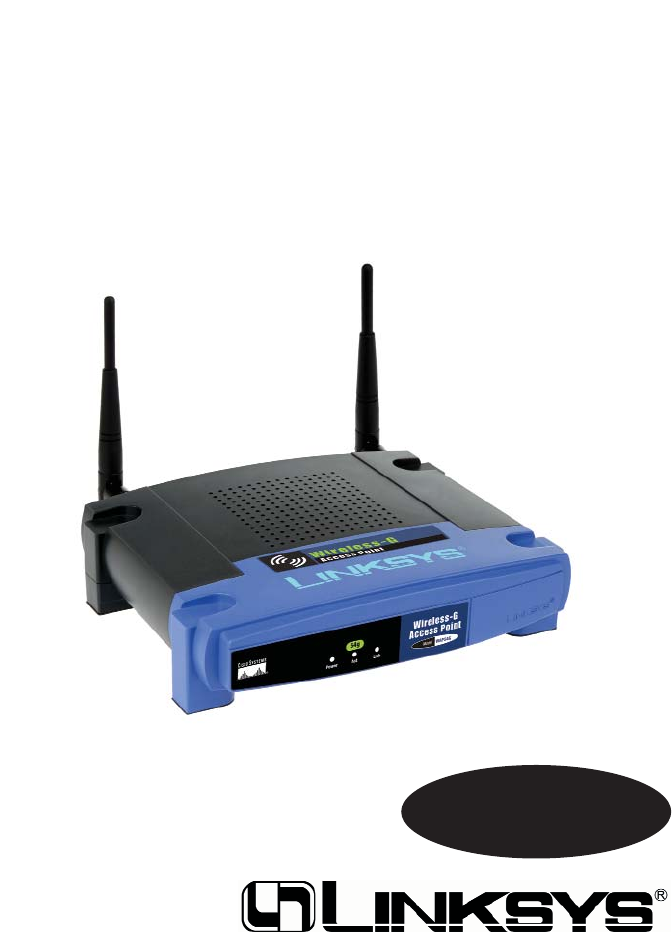
Wireless-G
Access Point
Use this guide to install:WAP54G v2 User Guide

COPYRIGHT & TRADEMARKS
Specifications are subject to change without notice. Linksys is a registered trademark or
trademark of Cisco Systems, Inc. and/or its affiliates in the U.S. and certain other coun-
tries. Copyright © 2003 Cisco Systems, Inc. All rights reserved. Other brands and prod-
uct names are trademarks or registered trademarks of their respective holders.
LIMITED WARRANTY
Linksys warrants to the original end user purchaser ("You") that, for a period of three years, (the
"Warranty Period”). Your Linksys product will be free of defects in materials and workmanship
under normal use. Your exclusive remedy and Linksys's entire liability under this warranty will
be for Linksys at its option to repair or replace the product or refund Your purchase price less
any rebates.
If the product proves defective during the Warranty Period call Linksys Technical Support in
order to obtain a Return Authorization Number. BE SURE TO HAVE YOUR PROOF OF PUR-
CHASE ON HAND WHEN CALLING. When returning a product, mark the Return Authorization
Number clearly on the outside of the package and include a copy of your original proof of pur-
chase. RETURN REQUESTS CANNOT BE PROCESSED WITHOUT PROOF OF PURCHASE.
You are responsible for shipping defective products to Linksys. Linksys pays for UPS Ground
shipping from Linksys back to You only. Customers located outside of the United States of
America and Canada are responsible for all shipping and handling charges.
ALL IMPLIED WARRANTIES AND CONDITIONS OF MERCHANTABILITY OR FITNESS FOR A
PARTICULAR PURPOSE ARE LIMITED TO THE DURATION OF THE WARRANTY PERIOD. ALL
OTHER EXPRESS OR IMPLIED CONDITIONS, REPRESENTATIONS AND WARRANTIES,
INCLUDING ANY IMPLIED WARRANTY OF NON-INFRINGEMENT, ARE DISCLAIMED. Some
jurisdictions do not allow limitations on how long an implied warranty lasts, so the above limi-
tation may not apply to You. This warranty gives You specific legal rights, and You may also
have other rights which vary by jurisdiction.
TO THE EXTENT NOT PROHIBITED BY LAW, IN NO EVENT WILL LINKSYS BE LIABLE FOR
ANY LOST DATA, REVENUE OR PROFIT, OR FOR SPECIAL, INDIRECT, CONSEQUENTIAL,
INCIDENTAL OR PUNITIVE DAMAGES, HOWEVER CAUSED REGARDLESS OF THE THEORY
OF LIABILITY, ARISING OUT OF OR RELATED TO THE USE OF OR INABILITY TO USE THE
PRODUCT, EVEN IF LINKSYS HAS BEEN ADVISED OF THE POSSIBILITY OF SUCH DAM-
AGES. IN NO EVENT WILL LINKSYS' LIABILITY EXCEED THE AMOUNT PAID BY YOU FOR
THE PRODUCT.
The foregoing limitations will apply even if any warranty or remedy provided under this Section
fails of its essential purpose. Some jurisdictions do not allow the exclusion or limitation of inci-
dental or consequential damages, so the above limitation or exclusion may not apply to You.
Please direct all inquiries to: Linksys, P.O. Box 18558, Irvine, CA 92623.
FCC STATEMENT
This (WAP54G v2) has been tested and complies with the specifications for
a Class B digital device, pursuant to Part 15 of the FCC Rules. These limits are designed
to provide reasonable protection against harmful interference in a residential installation.
This equipment generates, uses, and can radiate radio frequency energy and, if not
installed and used according to the instructions, may cause harmful interference to radio
communications. However, there is no guarantee that interference will not occur in a par-
ticular installation. If this equipment does cause harmful interference to radio or television
reception, which is found by turning the equipment off and on, the user is encouraged to
try to correct the interference by one or more of the following measures:
• Reorient or relocate the receiving antenna
• Increase the separation between the equipment or device
• Connect the equipment to an outlet other than the receiver’s
• Consult a dealer or an experienced radio/TV technician for assistance
Federal Communication Commission Interference Statement
This equipment has been tested and found to comply with the limits for a Class B digital device,
pursuant to Part 15 of the FCC Rules. These limits are designed to provide reasonable
protection against harmful interference in a residential installation. This equipment generates,
uses and can radiate radio frequency energy and, if not installed and used in accordance with
the instructions, may cause harmful interference to radio communications. However, there is no
guarantee that interference will not occur in a particular installation. If this equipment does cause
harmful interference to radio or television reception, which can be determined by turning the
equipment off and on, the user is encouraged to try to correct the interference by one of the
following measures:
- Reorient or relocate the receiving antenna.
- Increase the separation between the equipment and receiver.
- Connect the equipment into an outlet on a circuit different from that to which the receiver is
connected.
- Consult the dealer or an experienced radio/TV technician for help.
FCC Caution: To assure continued compliance, any changes or modifications not expressly
approved by the party responsible for compliance could void the user’s authority to operate this
equipment.
This device complies with Part 15 of the FCC Rules. Operation is subject to the following two
conditions: (1) This device may not cause harmful interference, and (2) this device must accept
any interference received, including interference that may cause undesired operation.
IMPORTANT NOTE:
FCC Radiation Exposure Statement:
This equipment complies with FCC radiation exposure limits set forth for an uncontrolled
environment. This equipment should be installed and operated with minimum distance 20cm
between the radiator & your body.
This transmitter must not be co-located or operating in conjunction with any other antenna or
transmitter.

Wireless-G Access Point
Table of Contents
Chapter 1: Introduction 1
The Instant Wireless Wireless-G Access Point 1
Features 1
Chapter 2: Planning Your Wireless Network 2
Network Topology 2
Roaming 2
Chapter 3: Getting to Know the Wireless-G
Access Point 3
The Wireless-G Access Point’s Back Panel 3
The Wireless-G Access Point’s Front Panel 4
Chapter 4: Connecting the Wireless-G
Access Point 5
Chapter 5: Setting Up the Wireless-G
Access Point 6
Chapter 6: Configuring the Wireless-G
Access Point 14
The Setup Tab 14
The Password Tab 18
The AP Mode Tab 19
The Status Tab 21
The Log Tab 23
The Help Tab 24
The Filter Tab 25
The Advanced Wireless Tab 27
The SNMP Tab 29
Appendix A: Troubleshooting 30
Frequently Asked Questions 30
INDUSTRY CANADA (CANADA)
This Class B digital apparatus complies with Canadian ICES-003.
Cet appareil numérique de la classe B est conforme à la norme NMB-003 du Canada.
The use of this device in a system operating either partially or completely outdoors may require
the user to obtain a license for the system according to the Canadian regulations.
EC DECLARATION OF CONFORMITY (EUROPE)
Linksys Group declares that the Instant Wireless™ Series products included in the Instant
Wireless™ Series conform to the specifications listed below, following the provisions of the EMC
Directive 89/336/EEC and Low Voltage Directive 73/23/EEC:
ETS 300-826, 301 489-1 General EMC requirements for Radio equipment.
EN 609 50 Safety
ETS 300-328-2 Technical requirements for Radio equipment.
Note: This equipment is intended to be used in all EU and EFTA countries. Outdoor use may
be restricted to certain frequencies and/or may require a license for operation. For more
details, contact Linksys Corporate Compliance.
Note: Combinations of power levels and antennas resulting in a radiated power level of above
100 mW are considered as not compliant with the above mentioned directive and are not
allowed for use within the European community and countries that have adopted the European
R&TTE directive 1999/5/EC and/or the CEPT recommendation Rec 70.03. For more details on
legal combinations of power levels and antennas, contact Linksys Corporate Compliance.
Linksys Group vakuuttaa täten että Instant Wireless IEEE 802.11 PC Card tyyppinen laite on
direktiivin 1999/5/EY, direktiivin 89/336/EEC ja direktiivin 73/23/EEC oleellisten vaatimusten ja
sitä koskevien näiden direktiivien muiden ehtojen mukainen.
Linksys Group déclare que la carte PC Instant Wireless IEEE 802.11 est conforme aux condi-
tions essentielles et aux dispositions relatives à la directive 1999/5/EC, la directive 89/336/EEC,
et à la directive 73/23/EEC.
Belgique B L’utilisation en extérieur est autorisé sur le canal 11 (2462 MHz), 12 (2467 MHz), et
13 (2472 MHz).
Dans le cas d’une utilisation privée, à l’extérieur d’un bâtiment, au-dessus d’un espace public,
aucun enregistrement n’est nécessaire pour une distance de moins de 300m. Pour une dis-
tance supérieure à 300m un enregistrement auprès de l’IBPT est requise. Pour une utilisation
publique à l’extérieur de bâtiments, une licence de l’IBPT est requise. Pour les enregistrements
et licences, veuillez contacter l’IBPT.
France F: Bande de fréquence restreinte: seuls les canaux 10, 11, 12, 13 (2457, 2462, 2467,
et 2472 MHz respectivement) doivent être utilisés en France.
Toute utilisation, qu'elle soit intérieure ou extérieure, est soumise à autorisation. Vous pouvez
contacter l'Autorité de Régulation des Télécommuniations
(<http://www.art-telecom.fr>) pour la procédure à suivre.
France F: Restricted frequency band: only channels 10, 11, 12, 13 (2457, 2462, 2467, and
2472 MHz respectively) may be used in France. License required for every indoor and outdoor
installations. Please contact ART for procedure to follow.
Deutschland D: Anmeldung im Outdoor-Bereich notwending, aber nicht genehmi-
gungspflichtig. Bitte mit Händler die Vorgehensweise abstimmen.
Germany D: License required for outdoor installations. Check with reseller for procedure to fol-
low
Italia I: E' necessaria la concessione ministeriale anche per l'uso interno. Verificare con i riven-
ditori la procedura da seguire. L'uso per installazione in esterni non e' permessa.
Italy I: License required for indoor use. Use with outdoor installations not allowed.
the Netherlands NL License required for outdoor installations. Check with reseller for proce-
dure to follow.
Nederlands NL Licentie verplicht voor gebruik met buitenantennes. Neem contact op met
verkoper voor juiste procedure

Wireless-G Access Point
Chapter 1: Introduction
Wireless-G Access Point
Wireless-G is the upcoming 54Mbps wireless networking standard that's
almost five times faster than the widely deployed Wireless-B (802.11b) prod-
ucts found in homes, businesses, and public wireless hotspots around the coun-
try — but since they share the same 2.4GHz radio band, Wireless-G devices
can also work with existing 11Mbps Wireless-B equipment.
The Linksys Wireless-G Access Point lets you connect Wireless-G or Wireless-
B devices to the network. Since both standards are built in, you can protect your
investment in existing 802.11b infrastructure, and migrate your network clients
to the new screaming fast Wireless-G standard as your needs grow.
To protect your data and privacy, the Wireless-G Access Point can encrypt all
wireless transmissions. The MAC Address filter lets you decide exactly who
has access to your wireless network. Configuration is a snap with the web
browser-based configuration utility.
Future-proof your wireless network with the Linksys Wireless-G Access Point.
You'll enjoy Wireless-B connectivity today, and be prepared for a high-speed
Wireless-G tomorrow.
• Set up a high-speed Wireless-G (802.11g) network in your home or office
• Data rates up to 54Mbps -- 5 times faster than Wireless-B (802.11b)
• Also interoperates with Wireless-B networks (at 11Mbps)
• Advanced wireless security with 128-bit WEP encryption, WPA, and MAC
filtering
• Free Technical Support—24 Hours a Day, 7 Days a Week, Toll-Free U.S.
Calls
• 3-Year Limited Warranty
1
Features
Appendix B: Setting Up the TCP/IP and
IPX Protocols 35
Setting Up TCP/IP in Windows 35
TCP/IP Setup for Windows 98 and Millennium 36
IPX Setup for Windows 98 and Millennium 36
TCP/IP Setup for Windows NT 4.0 37
IPX Setup for Windows NT 4.0 37
TCP/IP Setup for Windows 2000 38
IPX Setup for Windows 2000 38
TCP/IP Setup for Windows XP 39
Appendix C: Glossary 40
Appendix D: Specifications 48
Environmental 49
Appendix E: Warranty Information 50
Appendix F: Contact Information 51
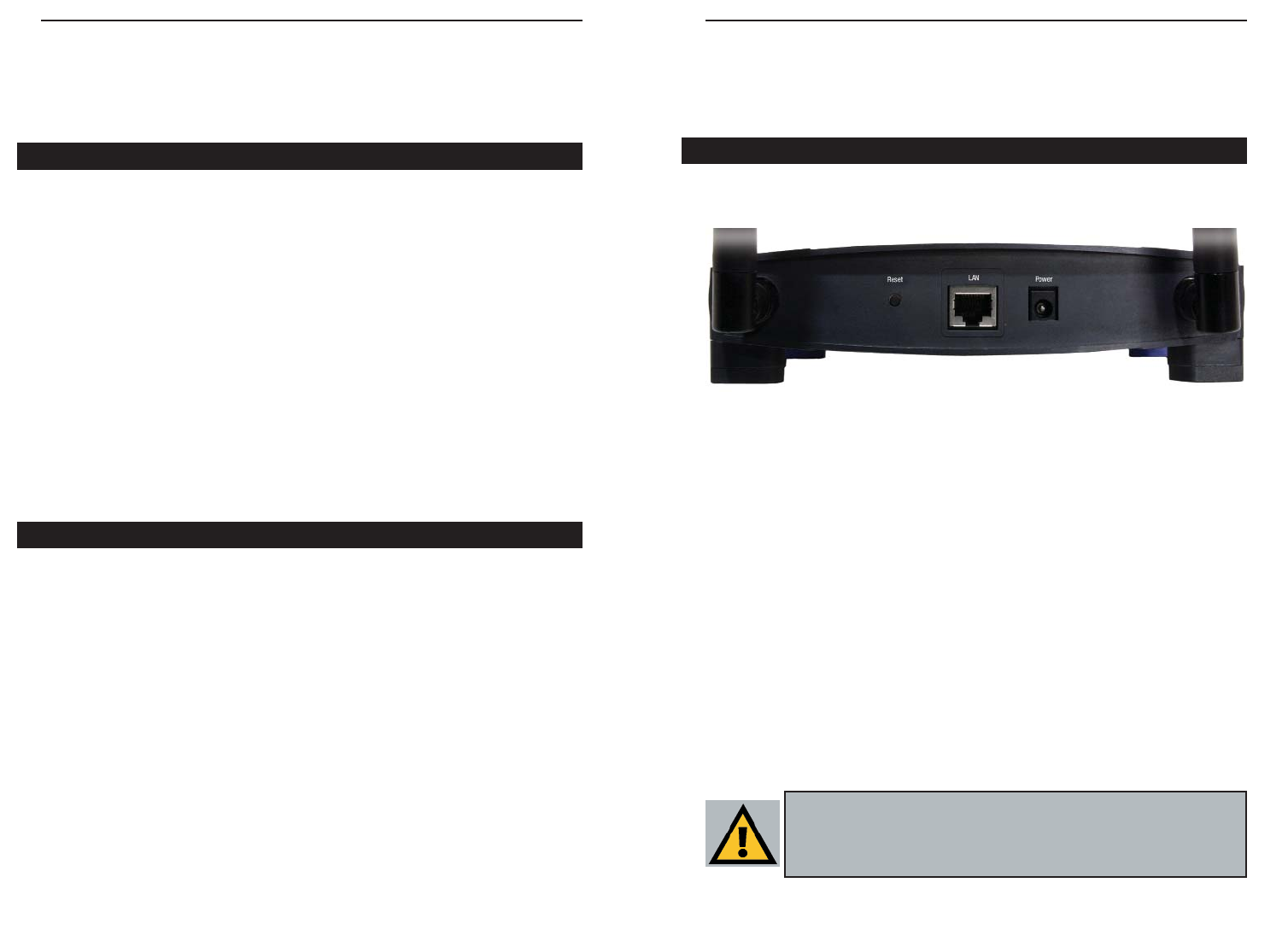
Wireless-G Access Point
Chapter 3: Getting to Know the
Wireless-G Access Point
The Access Point’s ports, where a network cable is connected, are located on
the Access Point’s back panel.
Reset Button There are two ways to Reset the Access Point’s factory
defaults. Either press the Reset Button using a small,
pointed object like a ball-point pen, for approximately ten
seconds, or restore the defaults from the password tab in
the Access Point’s Web-Based Utility.
LAN This LAN (Local Area Network) port connects to
Ethernet network devices, such as a hub, switch, or
router.
Power The Power port is where you will connect the power
adapter.
32
The Wireless-G Access Point’s Back Panel
Figure 3-1
Important: Resetting the Access Point will erase all of your settings
(WEP Encryption, Wireless and LAN settings, etc.) and replace
them with the factory defaults. Do not reset the Access Point if you
want to retain these settings
Chapter 2: Planning Your
Wireless Network
A wireless LAN is a group of computers, each equipped with one Instant
Wireless Series adapter. Computers in a wireless LAN must be configured to
share the same radio channel.
The Instant Wireless Series adapters provide access to a wired LAN for wire-
less workstations. An integrated wireless and wired LAN is called an infra-
structure configuration. A group of Instant Wireless Series adapter users and
an Instant Wireless Wireless-G Access Point compose a Basic Service Set
(BSS). Each Instant Wireless Series adapter PC in a BSS can talk to any com-
puter in a wired LAN infrastructure via the Wireless-G Access Point.
An infrastructure configuration extends the accessibility of an Instant Wireless
Series adapter PC to a wired LAN, and doubles the effective wireless trans-
mission range for two Instant Wireless Series adapter PCs. Since the Wireless-
G Access Point is able to forward data within its BSS, the effective transmis-
sion range in an infrastructure LAN is doubled.
Infrastructure mode also supports roaming capabilities for mobile users. More
than one BSS can be configured as an Extended Service Set (ESS). This con-
tinuous network allows users to roam freely within an ESS. All PCs equipped
with an Instant Wireless Series adapter within one ESS must be configured
with the same ESS ID and use the same radio channel.
Before enabling an ESS with roaming capability, choosing a feasible radio
channel and optimum Wireless-G Access Point position is recommended.
Proper Access Point positioning combined with a clear radio signal will great-
ly enhance performance.
Roaming
Network Topology
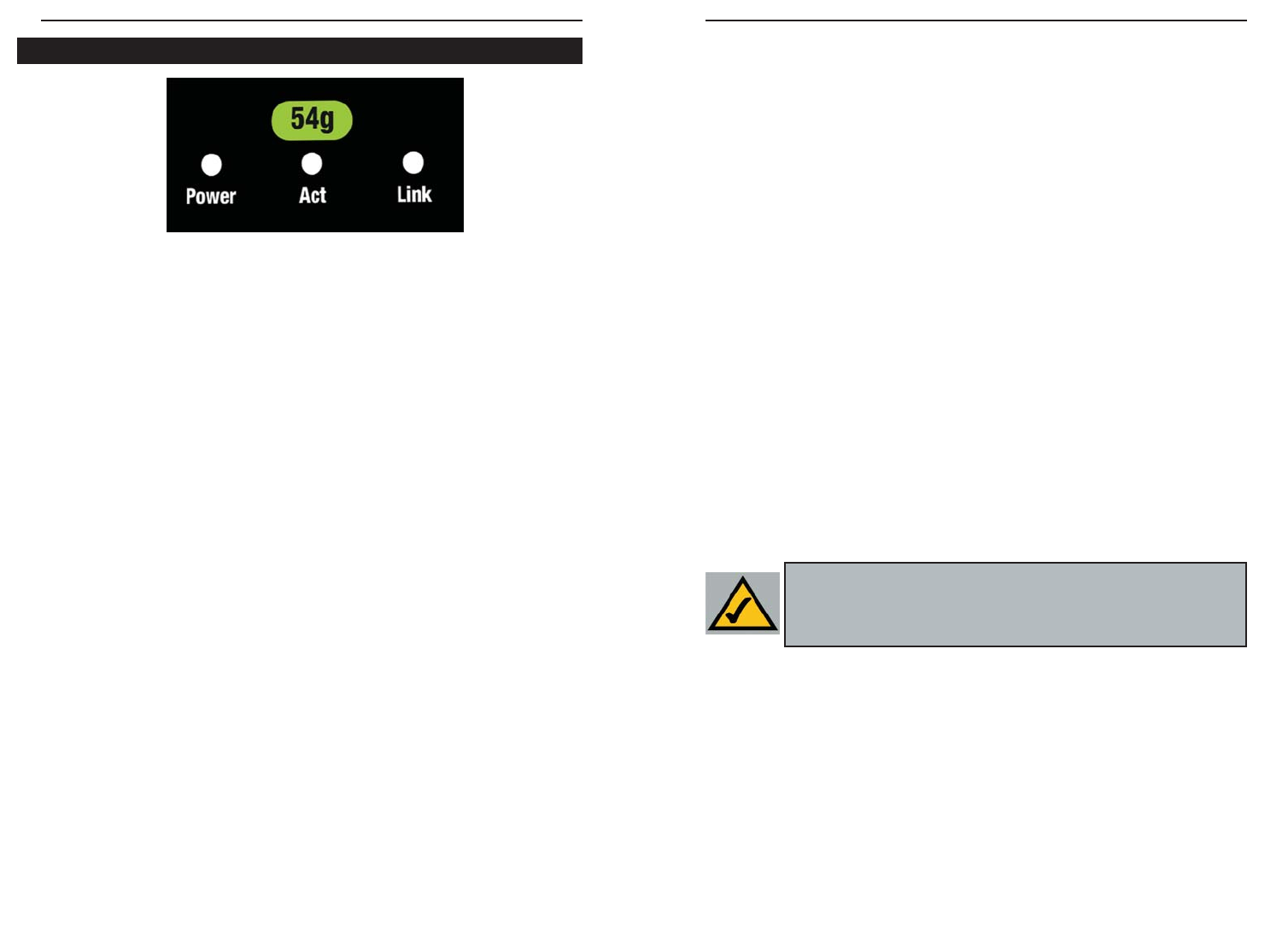
Wireless-G Access Point
Chapter 4: Connecting the
Wireless-G Access Point
1. Locate an optimum location for the Access Point. The best place for the
Access Point is usually at the center of your wireless network, with line of
sight to all of your mobile stations.
2. Fix the direction of the antenna. Try to place it in a position that can best
cover your wireless network. Normally, the higher you place the antenna,
the better the performance will be. The antenna’s position enhances the
receiving sensitivity.
3. Connect a standard Ethernet network cable to the Access Point. Then,
connect the other end of the Ethernet cable to a switch or hub. The Access
Point will then be connected to your 10/100 Network.
4. Connect the AC Power Adapter to the Access Point’s Power port and
plug the other end into an electrical outlet. Only use the power adapter
supplied with the Access Point. Use of a different adapter may result in
product damage.
Now that the hardware installation is complete, proceed to Chapter 5: Setting
Up the Wireless-G Access Point for directions on how to set up the Access
Point.
54
Note: In order for all other wireless devices to communicate with
the Access Point, those devices must be operating in
Infrastructure Mode. If any wireless devices are configured in
Ad Hoc Mode, they will not be recognized by the Access Point.
T
Power Green. The Power LED lights up when the Access Point is
powered on.
54g Act Green. If the Act LED is flickering, the Access Point is active
and ready for sending or receiving data to or from one of the
devices on the network.
Link Green. The Link LED lights whenever there is a successful
wireless connection.
The Wireless-G Access Point’s Front Panel
Figure 3-2
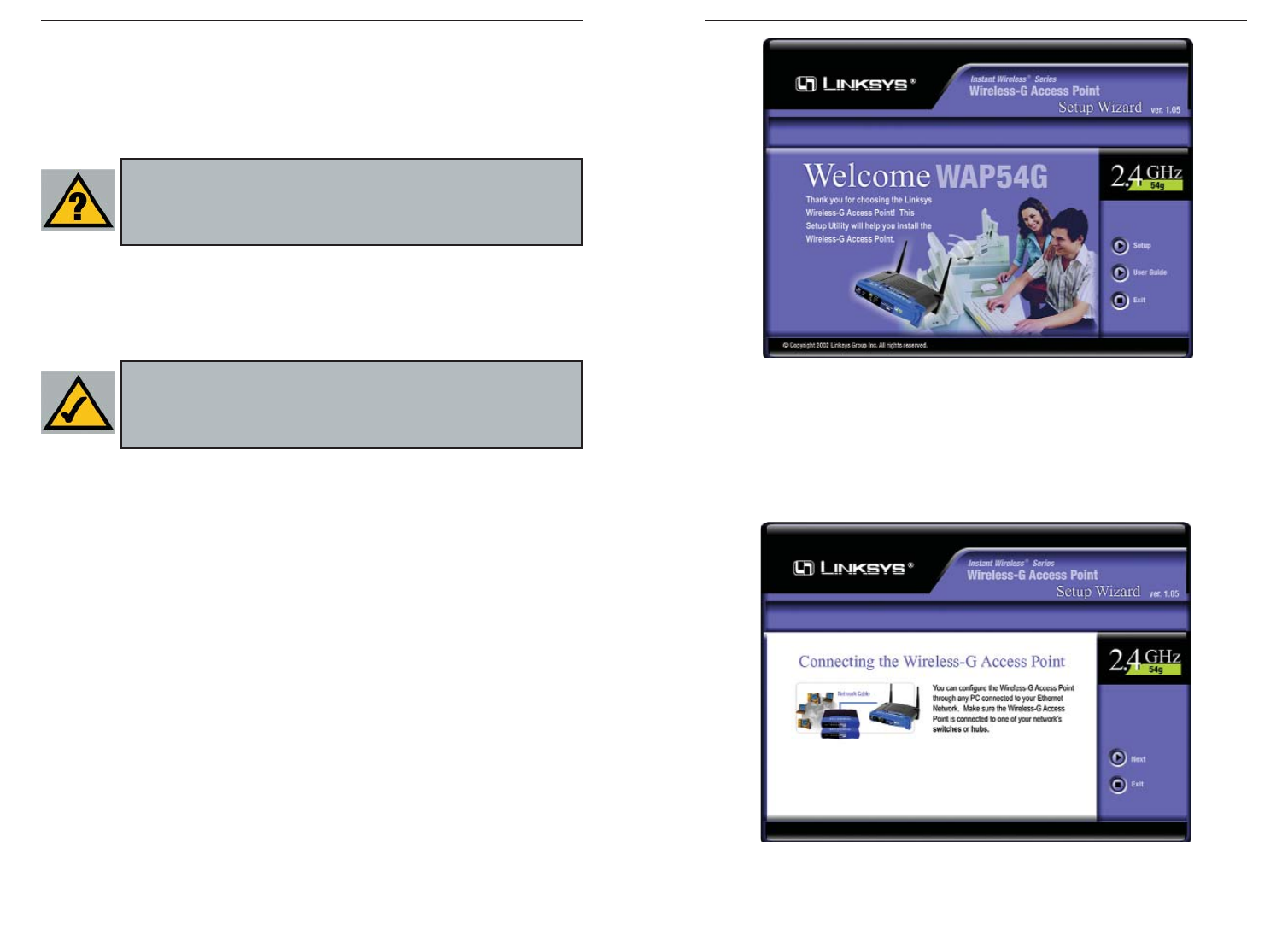
Wireless-G Access Point
3. The following screen, shown in Figure 5-2, displays how the Access Point
is configured in this Setup Wizard. Optimally, you should perform this
setup through a PC on your wired network. Click the Next button to con-
tinue or Exit to exit the Setup Wizard.
7
Chapter 5: Setting Up the
Wireless-G Access Point
Now that you’ve connected the Access Point to your wired network, you are
ready to begin setting it up. This Setup Wizard will take you through all the
necessary steps to configure the Access Point.
1. Insert the Setup Wizard CD into your PC’s CD-ROM drive. Your PC must
be on your wired network to set up the Access Point.
2. The Setup Wizard should run automatically, and the screen in Figure 5-1
should appear on your monitor. If it does not, start the Setup Wizard man-
ually by clicking the Start button, selecting Run, and typing d:\setup.exe
(where “D” is your PC’s CD-ROM drive). Click the Setup button to con-
tinue this Setup Wizard. Clicking the User Guide button opened this User
Guide. To exit this Setup Wizard, click the Exit button.
6
Figure 5-2
Figure 5-1
Have You: Connected the Access Point to a hub, switch or router
on your wired network as shown in Chapter 4: Connecting the
Wireless-G Access Point? The Access Point can only be set up
through your wired network.
Note: The Access Point has been designed to work correctly right
out of the box, but setting it up on a wireless computer will require
you to use the Linksys default settings. These settings can then be
changed with the Setup Wizard or Web-based Browser Utility.
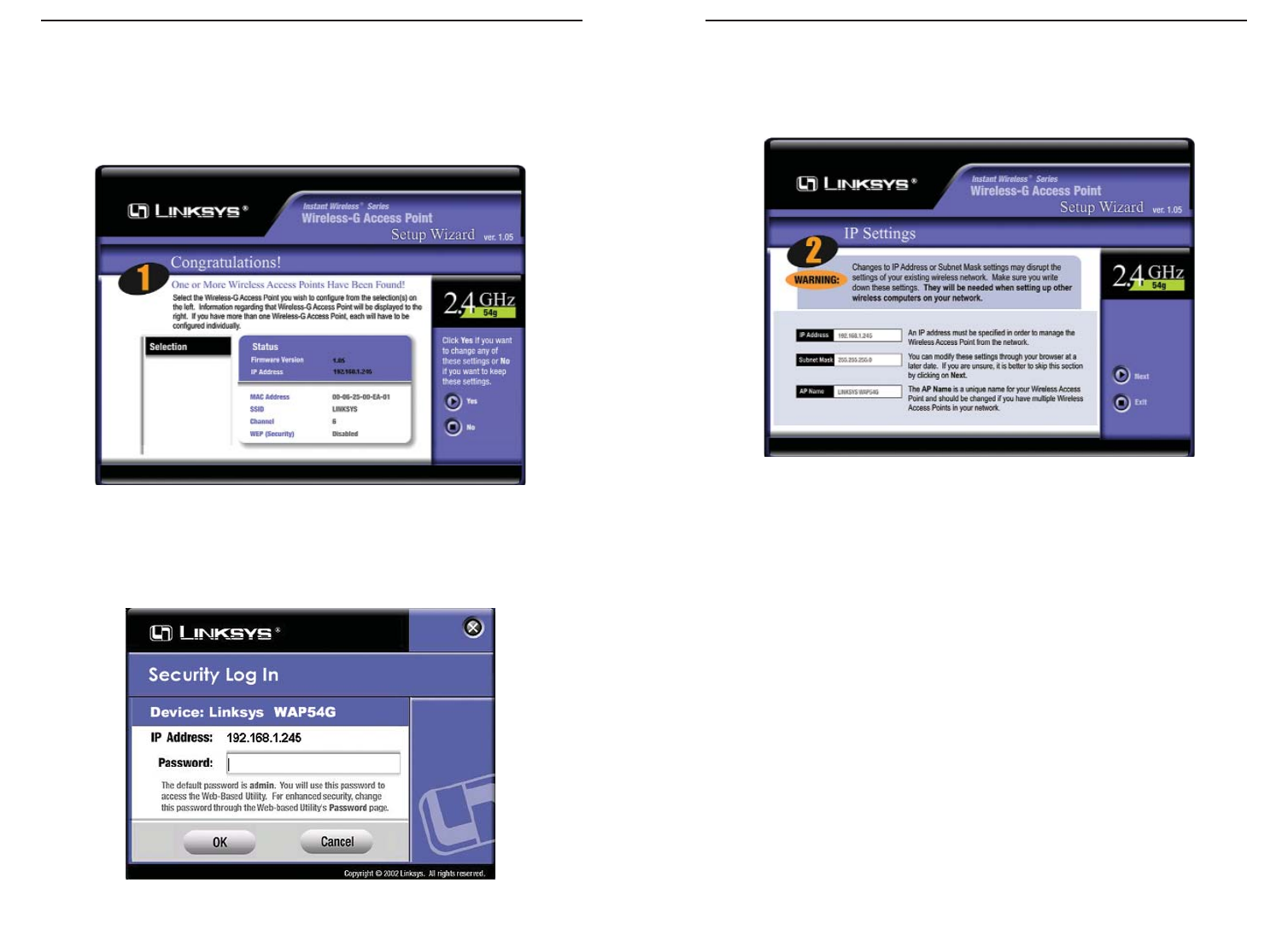
Wireless-G Access Point
6. As shown in Figure 5-5, the IP Settings screen will appear next. Enter an
IP Address, Subnet Mask, and enter a unique name for the Access Point that
is appropriate to your network. Then, click the Next button to continue or
Back to return to the previous page.
• IP Address. This IP address must be unique to your network. (The
default IP address is 192.168.1.245.)
• Subnet Mask. The Access Point’s Subnet Mask must be the same as your
Ethernet network.
• AP Name. Assign a name to the Access Point. Unique, memorable names
are helpful, especially if you are employing multiple access points on the
same network.
98
4. The next screen to appear, shown in Figure 5-3, will display a list of access
points on your network along with the status information for each access
point. If this is the only access point on your network, it will be the only one
displayed. If there are more than one displayed, select the Access Point by
clicking on it and click the Ye s button to continue or No to exit the Setup
Wizard.
5. You will be asked to sign on to the Access Point you’ve selected, as shown
in Figure 5-4. Enter the Password you’ve assigned. If none has been
assigned, enter the default password: admin. Then, click the OK button.
(This password can be changed at the Web-based Utility’s Password tab.)
Figure 5-3
Figure 5-4
Figure 5-5
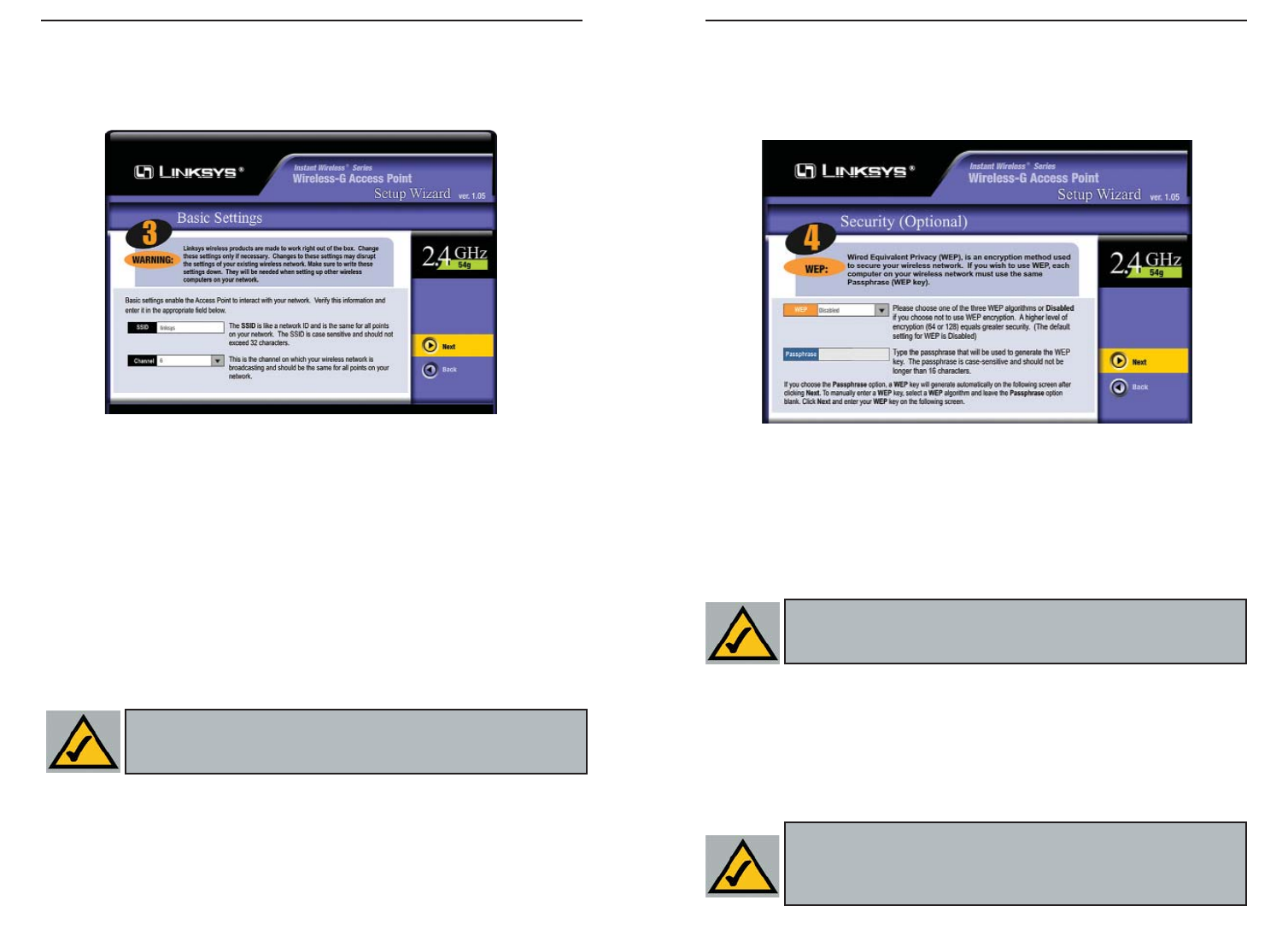
Wireless-G Access Point
8. The Security Settings screen (Figure 5-7) will appear next. From this
screen, you will set the Wired Equivalent Privacy (WEP) encryption for
your wireless network. Select a WEP configuration method and a
passphrase. Click the Next button to continue or Back to return to the pre-
vious page.
• WEP (Disable/64 bits (10 hex digits)/128 bits (26 hex digits)). In order
to utilize WEP encryption, select the WEP setting from the pull-down
menu, 64 bits (10 hex digits) or 128 bits (26 hex digits). If you do not
wish to utilize WEP encryption, make sure Disabled is selected. The
Access Point’s WEP encryption is unique to Linksys and may conflict
with other vendors’ WEP encryption.
• Passphrase. Instead of manually entering WEP keys, you can enter a
Passphrase. This Passphrase is used to generate one or more WEP keys.
It is case-sensitive and should not be longer than 16 alphanumeric char-
acters. (The Passphrase function is compatible with Linksys wireless
products only. If you want to communicate with non-Linksys wireless
products, you will need to enter your WEP keys manually on the non-
Linksys wireless products.)
1110
Figure 5-7
7. As shown in Figure 5-6, the Basic Settings screen will appear. Enter your
wireless network’s SSID and select the channel at which the network broad-
casts its wireless signal. Then, click the Next button to continue or Back to
return to the previous page.
• SSID. The SSID is the unique name shared among all devices in a wire-
less network. The SSID must be the same for all devices in the wireless
network. It is case sensitive, must not exceed 32 characters, and may be
any keyboard character.
• Channel. Select the appropriate channel from the list provided to corre-
spond with your network settings, between 1 and 11 (in North America).
All points in your wireless network must use the same channel in order
to function correctly. All points in your wireless network must use the
same channel in order to function correctly.
Figure 5-6
Note: The passphrase function doesn’t work when mixing other
manufacturers’ products into your wireless network. Linksys prod-
ucts should always be used for optimum functionality. If using
another company’s wireless product, set the WEP key manually.
Note:WEP encryption should be used when communicating over a
wireless network. Wireless transmissions are unprotected and WEP
encryption helps to make your wireless network safer to use.
Note:Cisco-Linksys declares that WAP54G v2 (FCC ID:
Q87-WAP54GV2) is limited in CH1-CH11 by specified
firmware controlled in USA.
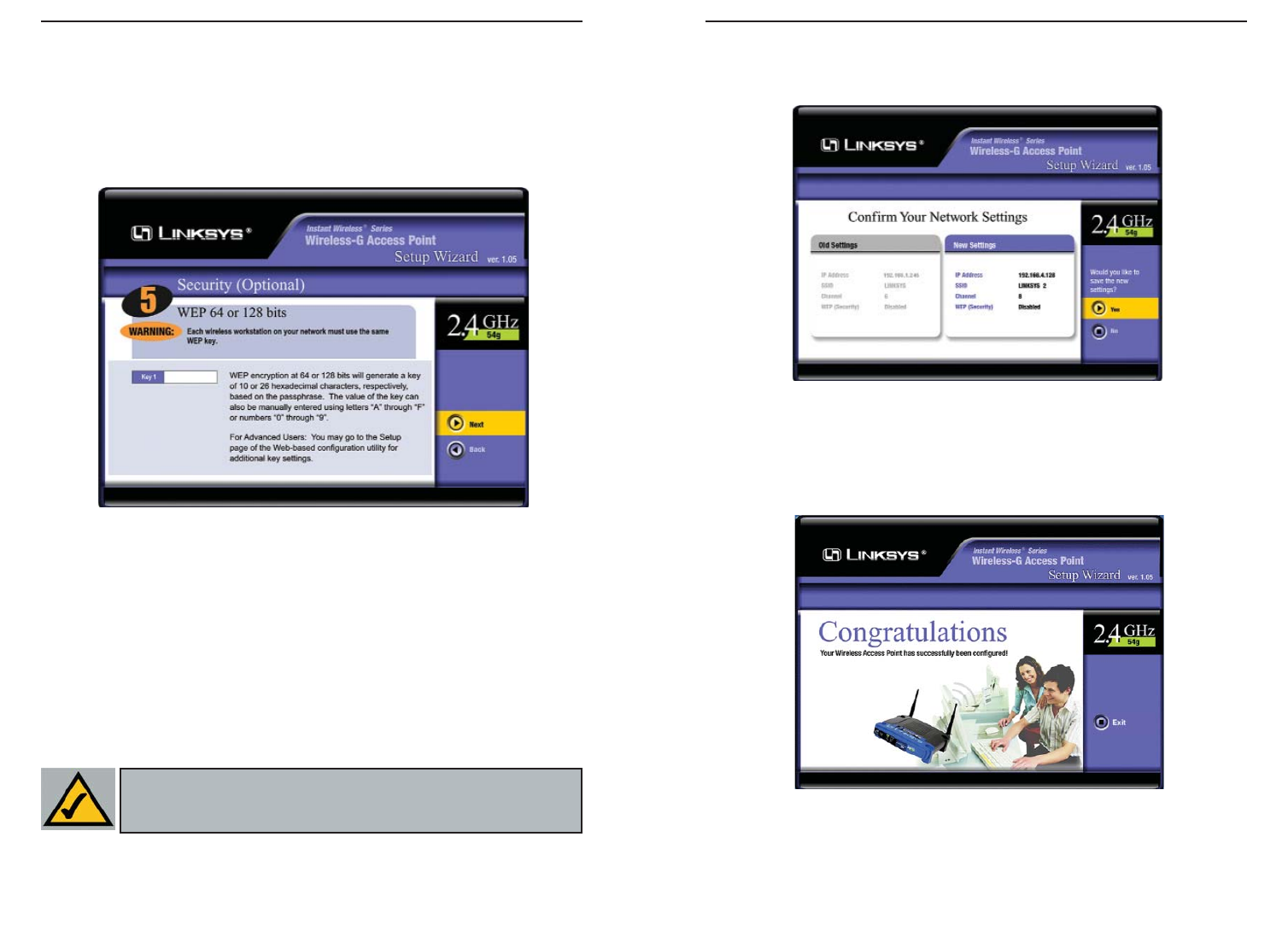
1312
Wireless-G Access Point
9. The second Security Settings screen, shown in Figure 5-8, shows the WEP
key. If you entered a passphrase, then the Key 1 field will display the auto-
matically generated WEP key. If you did not enter a passphrase, then enter
a WEP key in the Key 1 field. Each point in your wireless network must use
the same WEP key for the network to function properly. Click the Next but-
ton to continue or Back to return to the previous page.
• Key 1. WEP keys enable you to create an encryption scheme for wire-
less networks. If the WEP key hasn’t been automatically generated, then
manually enter a set of values. (Do not leave the field blank, and do not
enter all zeroes, because they are not valid key values.) If you are using
64-bit WEP encryption, then each key must consist of exactly 10 hexa-
decimal characters in length. If you are using 128-bit WEP encryption,
then each key must consist of exactly 26 hexadecimal characters in
length. Valid hexadecimal characters are “0”-“9” and “A”-“F”.
Figure 5-8
10. The next screen (Figure 5-9) will allow you to review your settings. If the
settings are correct, click the Ye s button to save them. Click the No button
to exit the Setup Wizard and not save the settings.
11. At this point, the configuration performed with the Setup Wizard is com-
plete, as shown in Figure 5-10. To configure any other access points in your
network, you can run this Setup Wizard again. Click the Exit button to exit
the Setup Wizard.
The installation and configuration of the Access Point is complete. For
more advanced configuration, proceed to Chapter 5: Configuring the
Wireless-G Access Point.
Figure 5-10
Figure 5-9
Note: WEP encryption should be used when communicating over a
wireless network. Wireless transmissions are unprotected and WEP
encryption helps to make your wireless network safer to use.
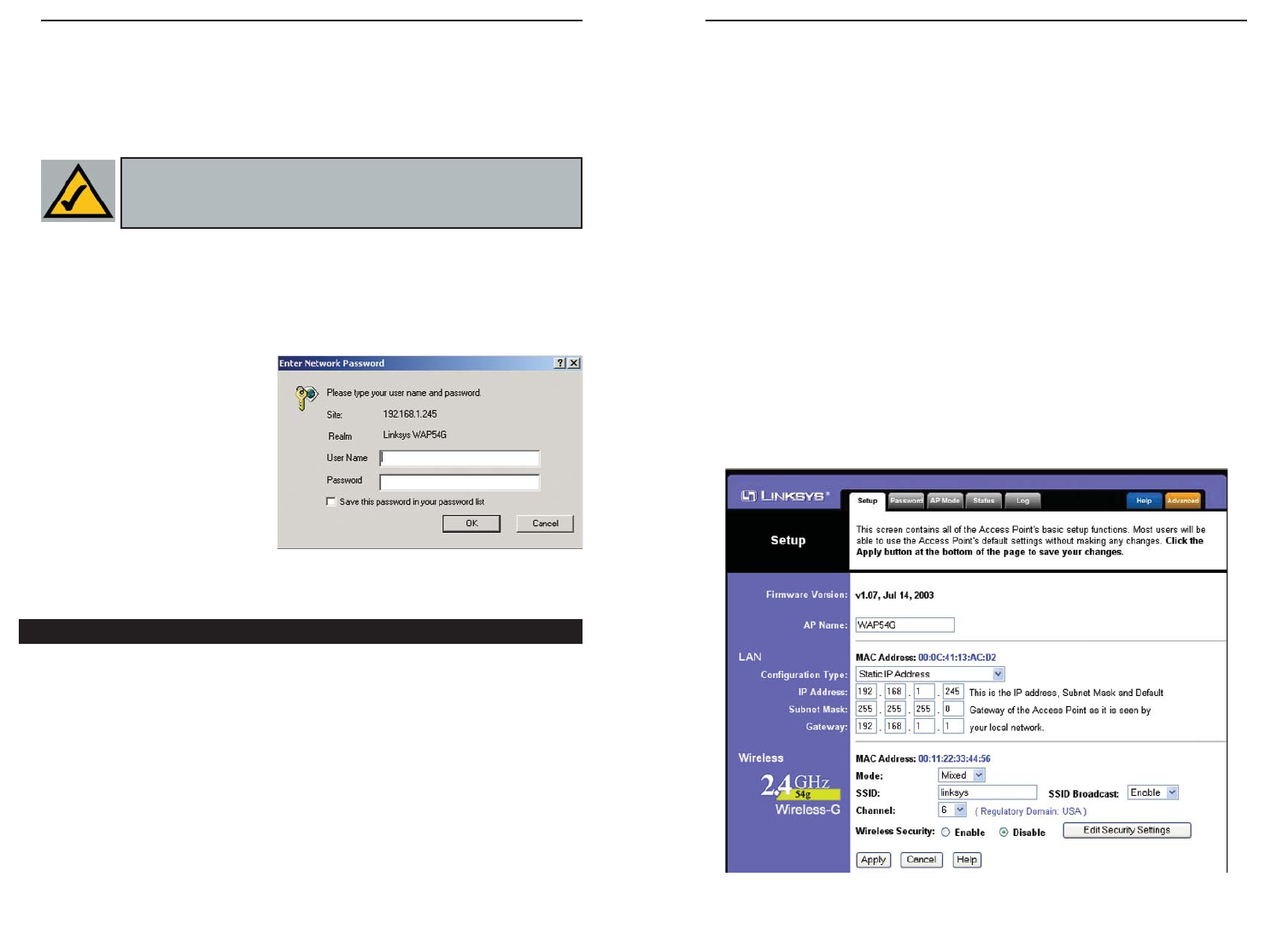
Wireless-G Access Point
1514
LAN
• MAC Address. The MAC Address of the LAN (Local Area Network)
interface is displayed here.
• Configuration Type. Select Static IP Address if your ISP provided you with
the IP Address, Subnet Mask, and default Gateway address or Select
Automatic Configuration - DHCP if your ISP assigns IP addresses via
DHCP.
• IP Address. The IP address must be unique to your network. We suggest
you use the default IP address of 192.168.1.245. This is a private IP address,
so there is no need to purchase a separate IP address from your service
provider. Verify the address and click the Apply button to save your changes.
• Subnet Mask. The Access Point’s Subnet Mask (or IP Mask) must be the
same as your Ethernet network. Verify this is correct and click the Apply
button to set it.
• Gateway. If you have assigned a static IP address to the Access Point, then
enter the IP address of your network’s Gateway, such as a router, in the Gateway
field. If your network does not have a Gateway, then leave this field blank.
Figure 6-2
Chapter 6: Configuring the
Wireless-G Access Point
The Access Point has been designed to be functional right out of the box, with
the default settings in the Setup Wizard. However, if you’d like to change these
settings, the Access Point can be configured through your web browser with the
Web-Based Utility. This chapter explains how to configure the Access Point in
this manner.
Open your web browser and type
the IP Address you entered in the
Setup Wizard (the default IP
address is 192.168.1.245). Press
the Enter key and the following
screen, shown in Figure 6-1, will
appear. Leave the User Name
field blank. The first time you
open the Web-based Utility, use
the default password admin. You
can set a new password on the
Password screen shown in Figure
6-5.
The first screen that appears, shown in Figure 6-2, is the Setup tab. This allows
you to change the Access Point’s general settings. Change these settings as
described here, and click the Apply button to apply your changes or Cancel to
cancel your changes. If you require online help, click the Help button.
• Firmware Version. This displays the current version of the Access Point’s
firmware. Firmware should only be upgraded if you experience problems
with the Access Point and can be upgraded from the Help tab.
• AP Name. You may assign any name to the Access Point. Unique, memo-
rable names are helpful, especially if you are employing multiple access
points on the same network. Verify this is the name you wish to use and
click the Apply button to set it.
Figure 6-1
The Setup Tab
Note: The Access Point is designed to function properly after
using the Setup Wizard. This chapter is provided solely for those
who wish to perform more advanced configuration or monitoring.
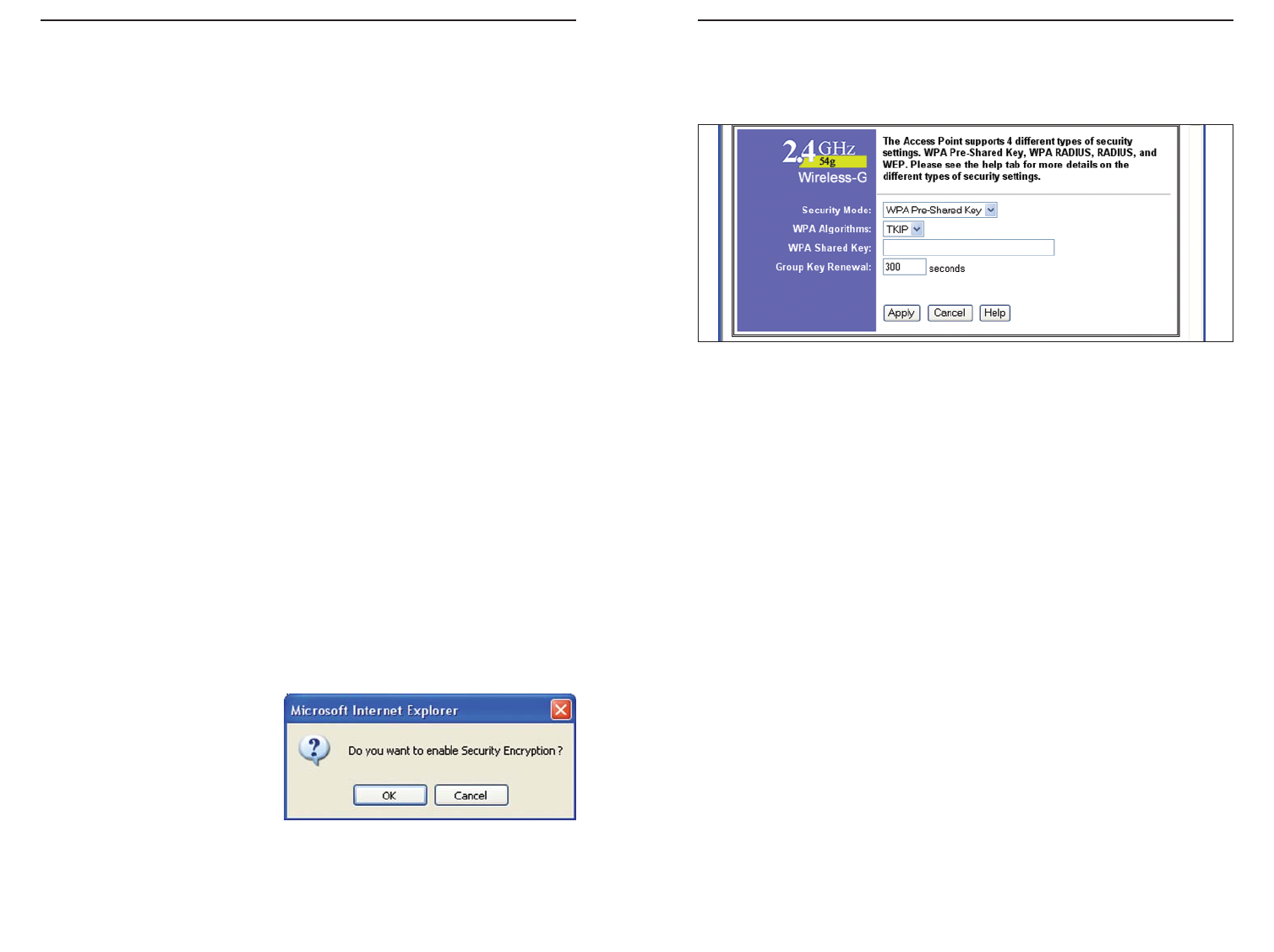
Wireless-G Access Point
1716
Wireless
• MAC Address. The MAC Address of the wireless (2.4 GHz, Draft
802.11g) interface is displayed here.
• Mode. Select Mixed and both Wireless-G and Wireless-B computers will be
allowed on the network, but the speed will be reduced. Select G-Only for
maximum speed, but no Wireless-B users will be allowed on the network.
Select B-Only mode for Wireless-B speed.
• SSID. The SSID is the unique name shared among all points in a wireless
network. The SSID must be identical for all points in the wireless network.
It is case-sensitive and must not exceed 32 alphanumeric characters, which
may be any keyboard character. Make sure this setting is the same for all
devices in your wireless network. For added security, Linksys recommends
that you change the SSID from the default linksys to a unique name.
• SSID Broadcast. Allows the SSID to be broadcast on your network. You may
want to enable this function while configuring your network, but make sure
that you disable it when you are finished. With this enabled, someone could
easily obtain the SSID information with site survey software and gain unau-
thorized access to your network. Click Enable to broadcast. Click Disable to
increase network security and prevent the SSID from being seen on networked
PCs.
• Channel. Select the appropriate channel from the list provided to corre-
spond with your network settings, between 1 and 11 (in North America). All
devices in your wireless network must use the same channel in order to
function correctly.
• Wireless Security. The Wireless Security is set to Disable by default. To
enable Wireless Security, click the Enable radio button, and then click the
Edit Security Settings button to configure the WEP settings.
SETTING WIRELESS SECURITY ENCRYPTION:
If the Disable radio button is
selected and you click the Edit
Security Settings button, then the
screen shown in Figure 6-3 will
appear. Click the OK button to
enable Security encryption or
Cancel to return to the Setup
screen.
Set Wireless Security through the Web-based Utility by clicking the Edit
Security Settings button on the Setup screen as shown in Figure 6-2.
Figure 6-3
This will open the Security Settings screen, Figure 6-4. From this screen, you can
select from four types of security settings for your network: Wi-Fi Protected
Access (WPA) Pre-Shared key, WPA Remote Access Dial In User Service
(RADIUS), RADIUS, or Wire Equivalence Protection (WEP).
• Security Mode. Select Wi-Fi Protected Access (WPA) Pre-Shared key,
WPA Remote Access Dial In User Service (RADIUS), RADIUS, or Wire
Equivalence Protection (WEP) from the drop-down menu.
• Pre-Shared Key. There are two encryption options for WPA Pre-Shared
Key, TKIP and AES. TKIP stands for Temporal Key Integrity Protocol.
TKIP utilizes a stronger encrytption method and incorporates Message
Integrity Code (MIC) to provide protection against hackers. AES stands for
Advanced Encryption System, which utilizes a symmetric 128-Bit block
data encryption. To use WPA Pre-Shared Key, enter a password in the WPA
Shared Key field between 8 and 63 characters long. You may also enter a
Group Key Renewal Interval time between 0 and 99,999 seconds.
• WPA RADIUS. WPA RADIUS uses an external RADIUS server to per-
form user authentication. To use WPA RADIUS, enter the IP address of the
RADIUS server, the RADIUS Port (default is 1812) and the shared secret
from the RADIUS server.
• RADIUS. RADIUS utilizes either a RADIUS server for authentication or
WEP for data encryption. To utilize RADIUS, enter the IP address of the
RADIUS server and its shared secret. Select the desired encryption bit (64
or 128) for WEP and enter either a passphrase or a manual WEP key.
• WEP encryption. From the pull-down menu, select 64 bits 10 hex digits
or 128-bit 26 hex digits for WEP encryption. Higher encryption levels
offer higher levels of security, but may decrease the network speed. Select
the desired encryption bit (64 or 128) for WEP and enter either a passphrase
or a manual WEP key.
Click the Apply button to apply your changes, or click Cancel to cancel your
most recent change, or click the Help button for more information.
Figure 6-4
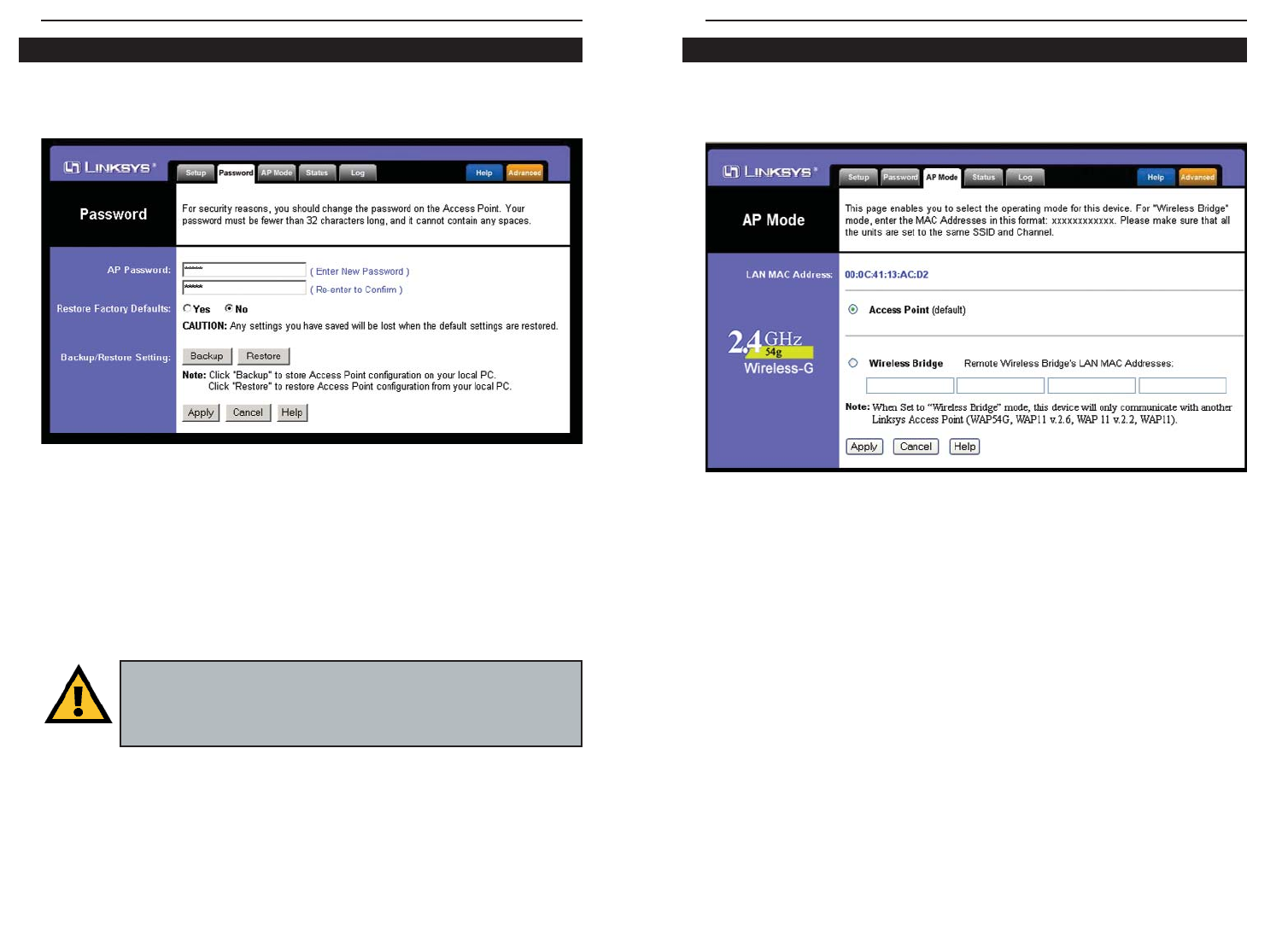
Wireless-G Access Point
SETTING THE AP MODE:
The Access Point offers two modes of operation: Access Point and Wireless
Bridge. For all bridging modes, make sure the channel, SSID, and WEP key set-
tings are the same.
• Access Point - The operational mode is set to Access Point by default. This
connects your wireless PCs to a wired network. In most cases, no change is
necessary.
• Wireless Bridge - If you are trying to make a wireless connection between
two or more wired networks, as shown in Figure 6-7, select Wireless
Bridge. This mode connects two physically separated wired networks with
two access points.
To configure a Wireless Bridge environment, click Wireless Bridge and
enter the LAN MAC address of the remote access point in the Remote
Wireless Bridge’s LAN MAC Addresses field. The remote access point also
needs to be set up as a Wireless Bridge.
Note: All devices on each wired network must be connected through a hub
or switch.
Click the Apply button to apply your changes or Cancel to cancel your
changes. If you require online help, click the Help button.
1918
The Password tab, shown in Figure 6-5, allows you to change the Access Point’s
password and restore factory defaults.
• AP Password. Changing the password for the Access Point is as easy as
typing the password into the AP Password field. Then, type it again into the
second field to confirm.
• Restore Factory Defaults. To restore the Access Point’s factory default set-
tings, click the Ye s button beside Restore Factory Defaults. You will lose
any settings you have saved.
• Backup/Restore Setting. To back up your Access Point configuration,
click the Backup button. To restore your Access Point configuration, click
the Restore button.
Click the Apply button to apply your changes or Cancel to cancel your
changes. If you require online help, click the Help button.
The Password Tab
Important: Restoring the Access Point’s factory defaults will erase
all of your settings (WEP Encryption, Wireless and LAN settings,
etc.), replacing them with the factory defaults. Do not reset the
Access Point if you want to retain these settings
Figure 6-5
Figure 6-6
The AP Mode Tab
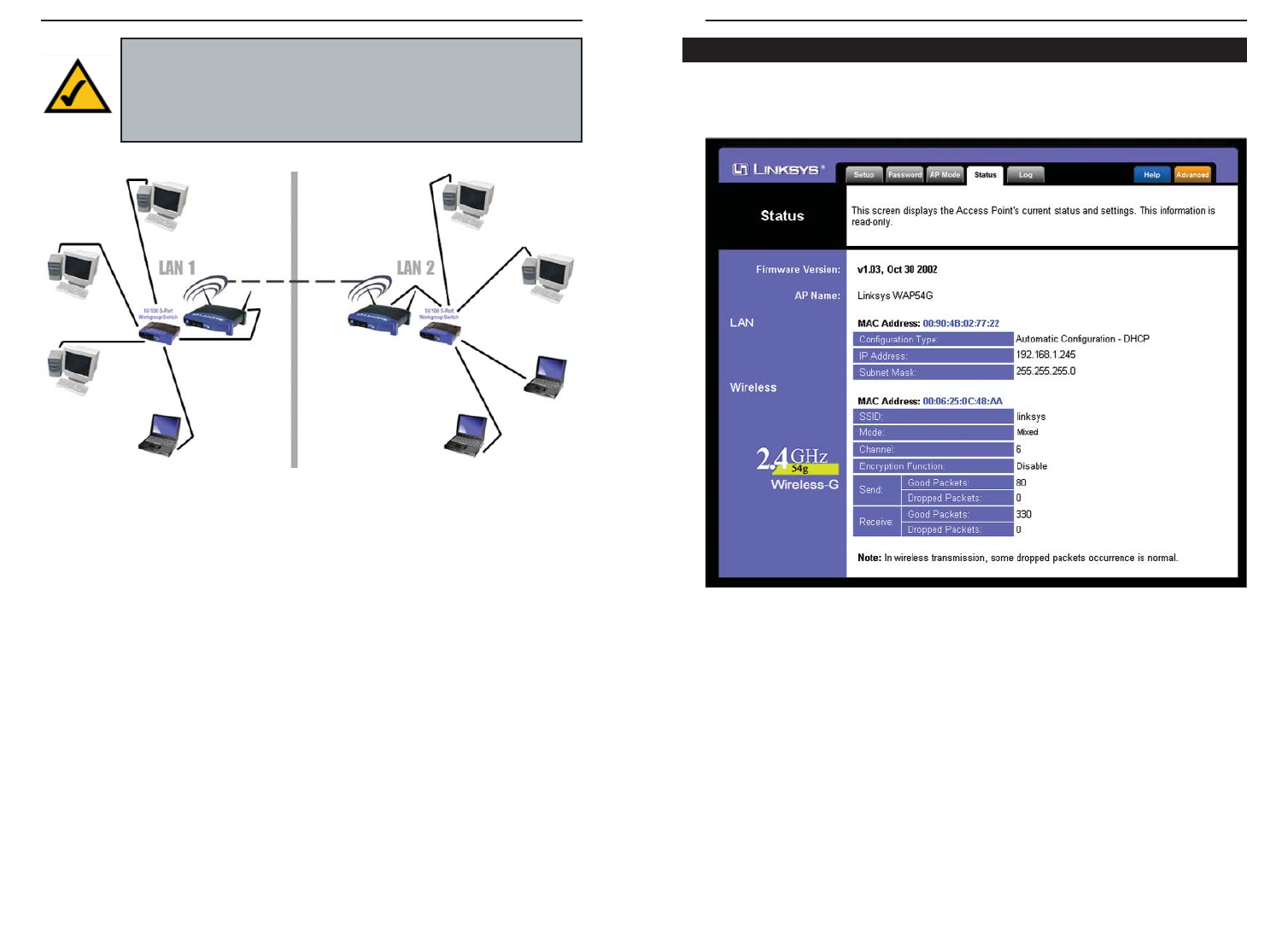
Wireless-G Access Point
21
The Status tab, shown in Figure 6-8, will display current information on the
Access Point, its settings, and its performance.
• Firmware Version. The current version of the Access Point’s firmware is
displayed. Firmware should only be upgraded from the Help tab if you
experience problems with the Access Point.
• AP Name. This displays the name you assigned to the Access Point.
Figure 6-8
The Status Tab
20
Note: In Wireless Bridge mode, the Access Point can ONLY be
accessed by another access point that is in Wireless Bridge mode. In
order for your other wireless devices to access the Access Point, you
must reset it to Access Point mode. The two modes are mutually
exclusive.
Figure 6-7
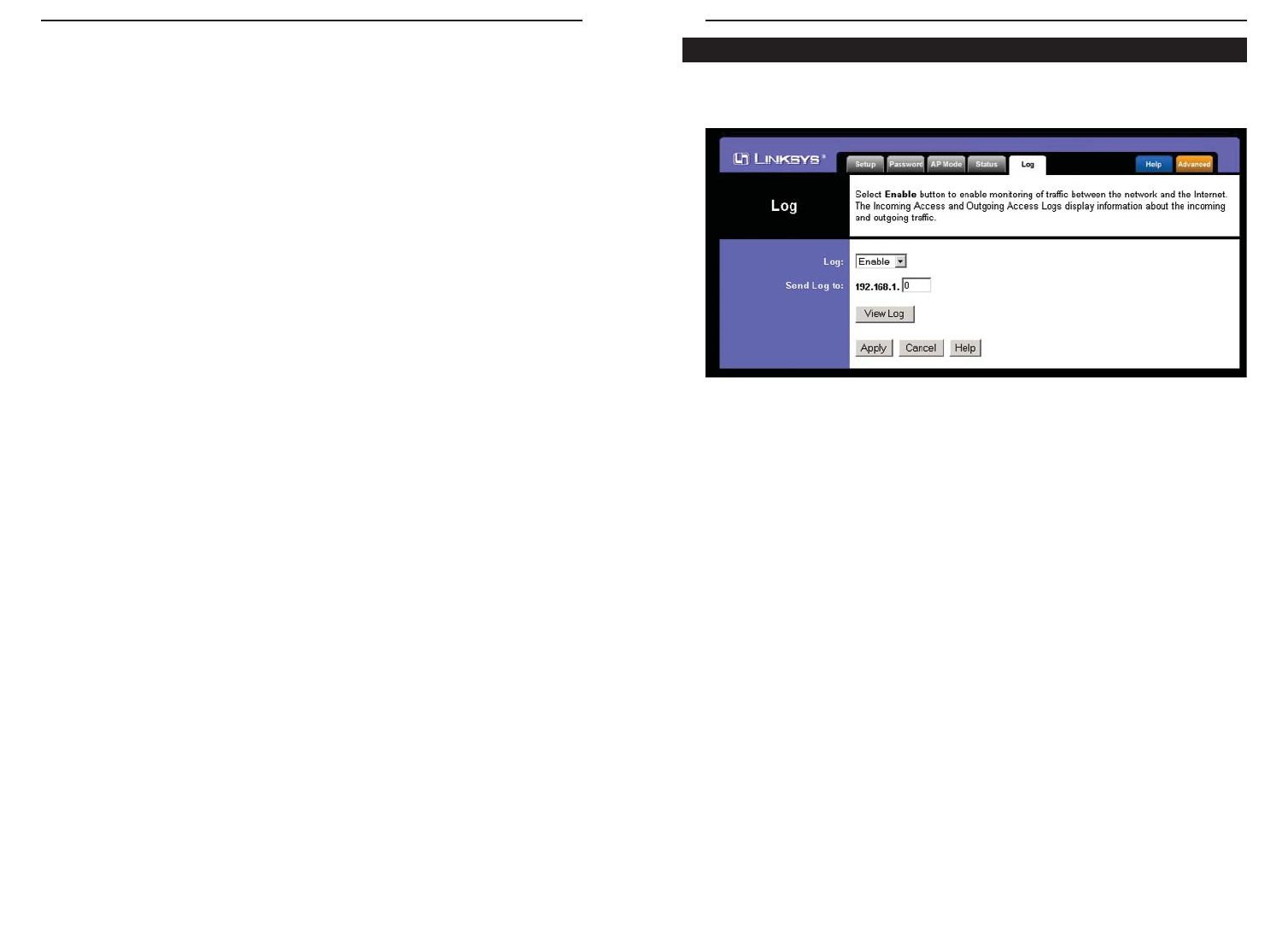
Wireless-G Access Point
2322
To view a log of the Access Point’s activity, select the Log tab, shown in Figure
6-9.
Log. To enable permanent logging activity, select Enable from the drop-down
menu beside Log. The default setting for this function is Disable.
If you have chosen to monitor the Access Point’s traffic, then you can designate
a PC that will receive permanent log files periodically. In the Send Log to field,
enter the IP address of this PC. To view these permanent logs, you must use
Logviewer software, which can be downloaded free of charge from
www.linksys.com.
To see a temporary log of the Access Point’s most recent activities, click the
View Log button.
Click the Apply button to apply your changes or Cancel to cancel your
changes. If you require online help, click the Help button.
The Log Tab
Figure 6-9
LAN
• MAC Address. The MAC Address of the LAN interface is displayed here.
• Configuration Type. This displays how the Access Point is assigned an IP
address, either Automatic Configuration - DHCP, if assigned by DHCP
server, or Static IP Address and its IP Address, Subnet Mask, and Default
Gateway address, if assigned by Static IP Address server.
• IP Address. This IP address is the unique IP address of the Access Point.
• Subnet Mask. The Access Point’s Subnet Mask (also known as an IP
Mask), matches the Subnet Mask of your Ethernet network.
Wireless
• MAC Address. The MAC Address of the LAN interface is displayed here.
• SSID. The unique name shared among all points in your wireless network
is displayed here.
• Mode. The Access Point’s mode is displayed here.
• Channel. The wireless channel shared by all wireless devices connected to
this Access Point is displayed here.
• Encryption Function. The encryption method you chose in the Setup
Wizard or changed from the Setup tab of this Web-based Utility is displayed
here.
• Send and Receive. The Send and Receive fields display the number of suc-
cessful or dropped packets that have been sent or received. Some packet
loss is normal in wireless networking.
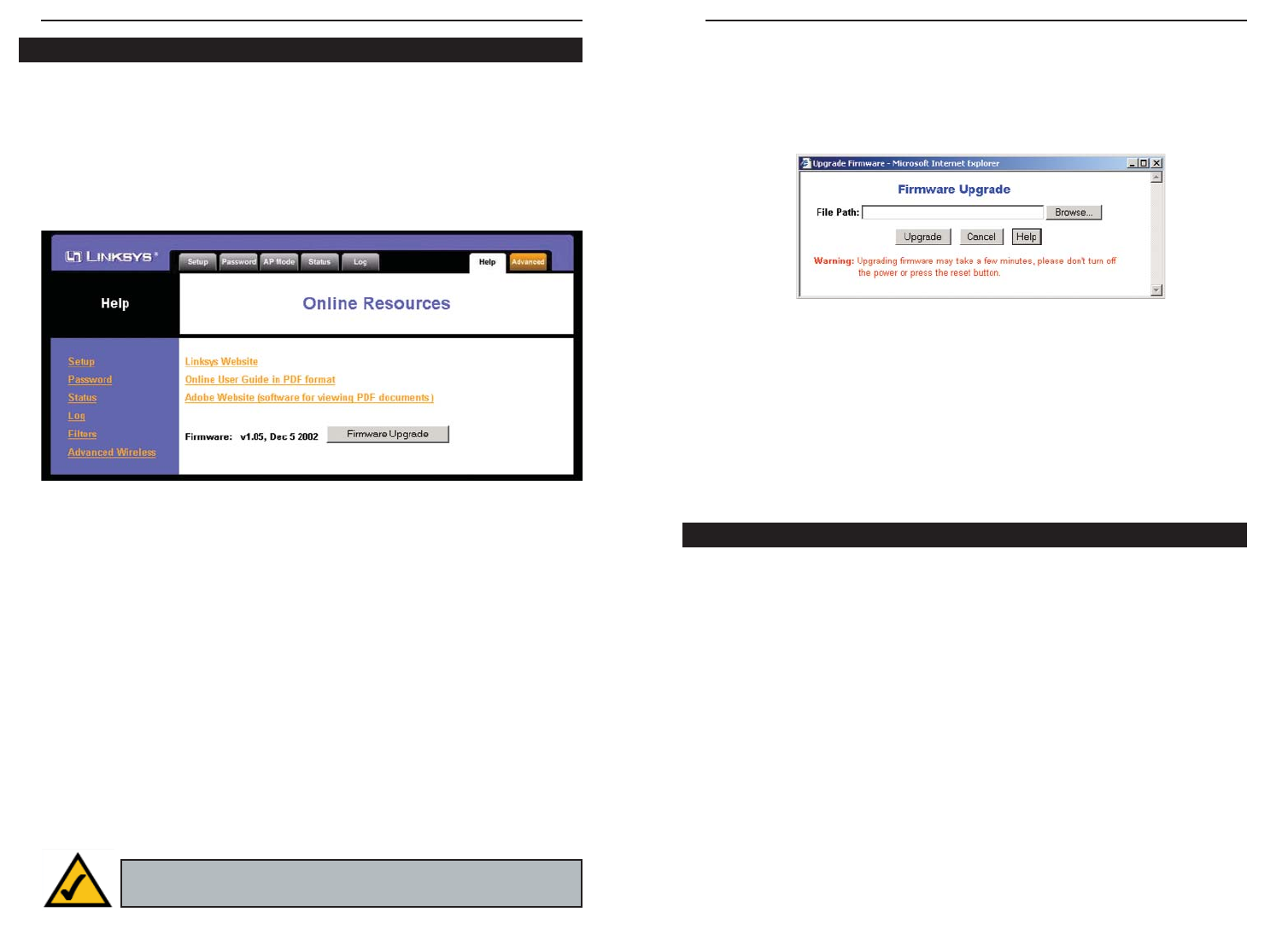
Wireless-G Access Point
2524
To upgrade the Access Point’s firmware:
1. Download the firmware upgrade file from the Linksys website.
2. Extract the firmware upgrade file.
3. Click the Upgrade Firmware button on the Help screen.
4. Enter the location of the firmware upgrade file in the File Path field, or
click the Browse button to find the firmware upgrade file.
5. Double-click the firmware upgrade file.
6. Click the Upgrade button, and follow the on-screen instructions.
Click the Cancel button to cancel the firmware upgrade.
To access the Filters tab, first click the Advanced tab. The Filters tab, shown
in Figure 6-12, allows you to control which computers may or may not com-
municate with the Access Point—depending on their MAC addresses.
To enable filtering of computers by their MAC Addresses, select Enable from
the drop-down menu. To disable this feature, select the default Disable.
Next, determine if the Access Point will Prevent or Permit access to the PCs
you will specify. If you want to block specific PCs from communicating with
with the Access Point, click the radio button next to Prevent PCs listed below
from accessing the wireless network. If you want to allow specific PCs from
communicating with the Access Point, click the radio button next to Permit
PCs listed below to access the wireless network.
The Filter Tab
For help on the various tabs in this Web-based Utility, along with upgrading the
Access Point’s firmware and viewing this User Guide, click the Help tab,
shown in Figure 6-10.
The help files for the various tabs in this Web-based Utility are listed by tab
name on the lefthand side of the screen.
Click the Linksys Website link to connect to the Linksys home page for
Knowledgebase help files and information about other Linksys products, pro-
vided you have an active Internet connection.
For an Online manual in PDF format, click that text link. The User Guide will
appear in Adobe pdf format. If you do not have the Adobe PDF Reader installed
on your computer, click the Adobe Website link or go to the Setup Wizard CD-
ROM to download this software. (To access the Adobe website, you will need an
active Internet connection.) To download from the CD-ROM, click the Start but-
ton and select Run. Type D:\Acrobat (if “D” is the letter of your CD-ROM drive).
New firmware versions are posted at www.linksys.com and can be downloaded
for free. If the Access Point is not experiencing difficulties, then there is no
need to download a more recent firmware version, unless that version has a
new feature that you want to use. Loading new firmware does not always
enhance the speed or quality of your Internet connection.
The Help Tab
Figure 6-10
Figure 6-11
Note: When you upgrade the Access Point’s firmware, you may
lose the Access Point’s current configuration settings.
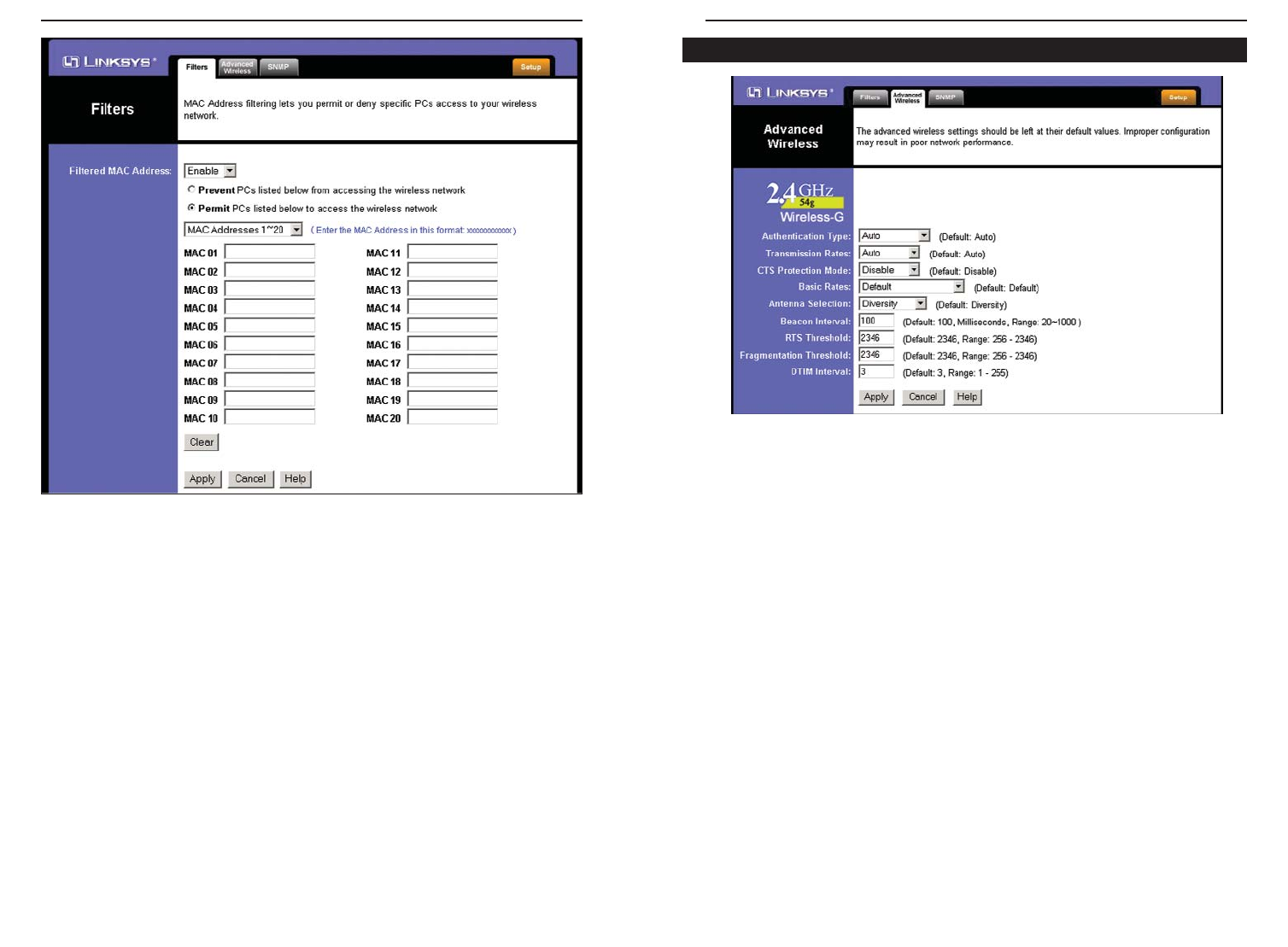
Wireless-G Access Point
2726
Before making any changes to the Advanced Wireless tab, shown in Figure 6-
13, please check your wireless settings on your other systems, because these
changes will alter the effectiveness of the Access Point. In most cases, these
wireless settings do not need to be changed.
• Authentication Type. The default is set to Auto, where it auto-detects for
Shared Key or Open System. Shared Key is when both the sender and the
recipient share a WEP key for authentication. Open Key is when the sender
and the recipient do not share a WEP key for authentication. All points on
your network must use the same authentication type.
• Transmission Rates. The default setting is Auto. The range is from 1 to
54Mbps. The rate of data transmission should be set depending on the speed
of your wireless network. You can select from a range of transmission
speeds, or you can keep the default setting, Auto, to have the Access Point
automatically use the fastest possible data rate and enable the Auto-Fallback
feature. Auto-Fallback will negotiate the best possible connection speed
between the Access Point and a wireless client.
• CTS Protection Mode. The default value is set to Disabled. When set to
Auto, a protection mechanism will ensure that your Wireless-B devices will
connect to the Access Point when many Wireless-G devices are present.
However, performance of your Wireless-G devices may be decreased.
Figure 6-13
Above the MAC Address fields, there is a pull-down menu. This drop-down
menu is for selecting the number of computers on your wireless network. For
computers one through twenty on your wireless network, 1~20 is selected by
default. If you have more than twenty computers on your wireless network, use
this pull-down menu to select 21~40.
Then, type the MAC Address(es) you wish to filter in the MAC Address fields.
Do not use colons when entering the digits. Use a xxxxxxxxxxxx format with
the x’s representing the actual characters of the MAC address. If you want to
clear the MAC addresses you entered, click the Clear button.
When you’ve completed making any changes on this tab, click the Apply but-
ton to save those changes or Cancel to cancel your changes. For more infor-
mation on this tab, click the Help button.
Figure 6-12
The Advanced Wireless Tab
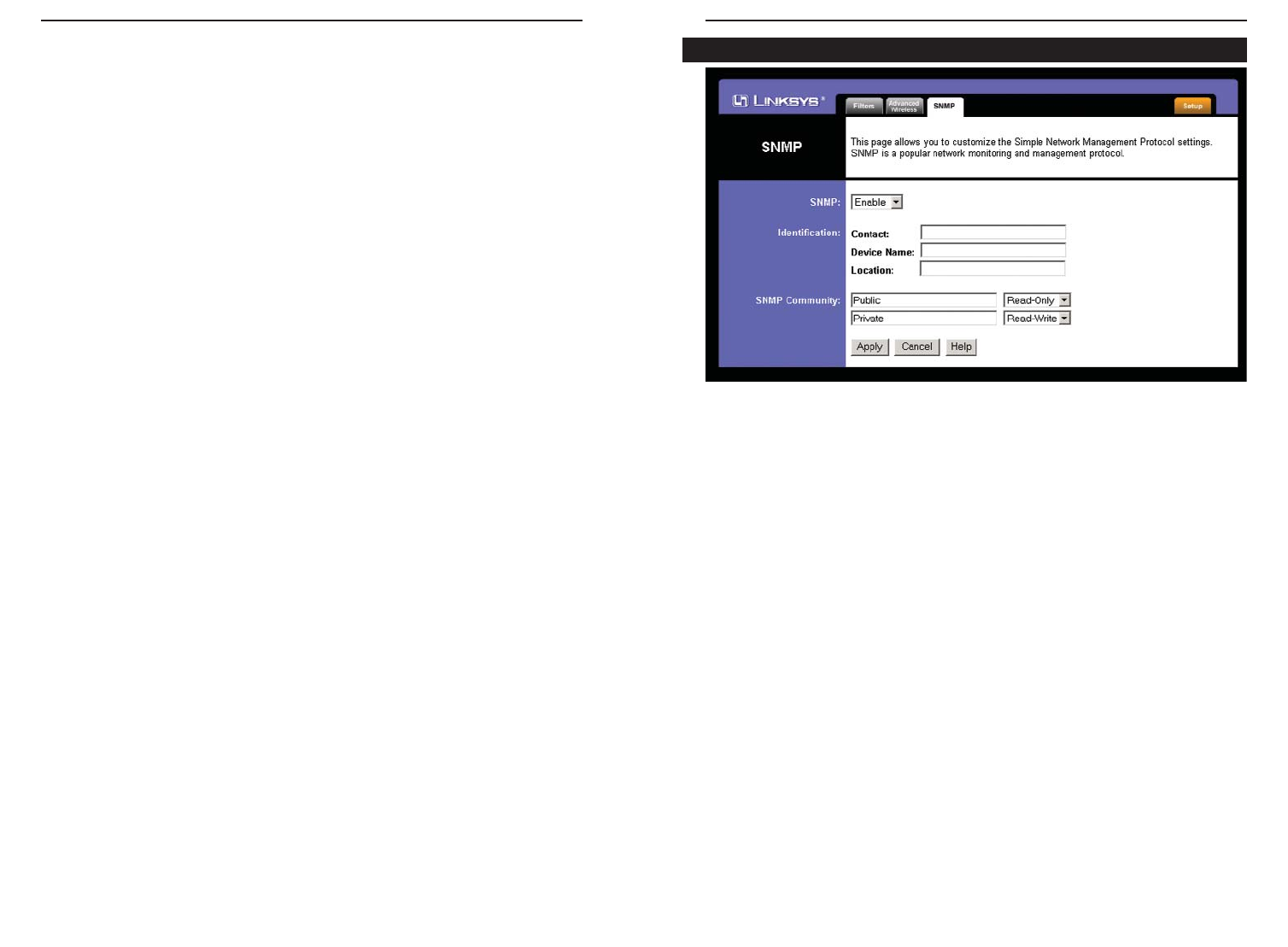
Wireless-G Access Point
2928
The SNMP screen allows you to customize the Simple Network Management
Protocol (SNMP) settings. SNMP is a popular network monitoring and man-
agement protocol.
The Identification settings let you designate the Contact, Device Name, and
Location information for the Access Point. The SNMP Community settings
allow names to be assigned to any SNMP communities that have been set up in
the network. You can define two different SNMP communities, with the default
names being Public and Private.
• SNMP. To enable the SNMP support feature, select Enable. Otherwise,
select Disable.
• Identification. In the Contact field, enter contact information for the
Access Point. In the Device Name field, enter the name of the Access Point.
In the Location field, specify the area or location where the Access Point
resides.
• SNMP Community. You may change the name from its default, Public.
Enter a new name in the Public field. Then configure the community's
access as either Read-Only or Read-Write.You may change the name from
its default, Private. Enter a new name in the Private field. Then configure
the community's access as either Read-Only or Read-Write.
When you’ve completed making any changes on this tab, click the Apply but-
ton to save those changes or Cancel to cancel your changes. For more infor-
mation on this tab, you can click the Help button.
• Basic Rate. The default value is set to Default. Depending on the wireless
mode you have selected, a default set of supported data rates will be select-
ed. The default setting will ensure maximum compatibility with all devices.
You may also choose to enable all data rates by selecting ALL. For com-
patibility with older Wireless-B devices, select 1-2Mbps.
• Antenna Selection. The default value is set to Diversity. In Diversity mode,
both antennas will be enabled. Otherwise, you can set to have wireless
transmission operate only on the Left or Right antenna.
• Beacon Interval. This value indicates the frequency interval of the beacon.
The default value is 100. Enter a value between 20 and 1000 milliseconds.
The Beacon Interval value indicates the frequency interval of the beacon. A
beacon is a packet broadcast by the Access Point to synchronize the wire-
less network.
• RTS Threshold. This value should remain at its default setting of 2346.
Should you encounter inconsistent data flow, only minor reductions are rec-
ommended.
• Fragmentation Threshold. This value specifies the maximum size for a
packet before data is fragmented into multiple packets. It should remain at
its default setting of 2346. A smaller setting means smaller packets, which
will create more packets for each transmission. Only minor reductions of
this value are recommended.
• DTIM Interval. The default value is 3. This value, between 1 and 255 mil-
liseconds, indicates the interval of the Delivery Traffic Indication Message
(DTIM). A DTIM field is a countdown field informing clients of the next
window for listening to broadcast and multicast messages. When the Access
Point has buffered broadcast or multicast messages for associated clients, it
sends the next DTIM with a DTIM Interval value. Access Point Clients
hear the beacons and awaken to receive the broadcast and multicast mes-
sages.
When you’ve completed making any changes on this tab, click the Apply but-
ton to save those changes or Cancel to cancel your changes. For more infor-
mation on this tab, you can click the Help button.
The SNMP Tab
Figure 6-14

Wireless-G Access Point
What is Roaming?
Roaming is the ability of a portable computer user to communicate continu-
ously while moving freely throughout an area greater than that covered by a
single Access Point. Before using the roaming function, the workstation must
make sure that it is the same channel number as the Access Point of the dedi-
cated coverage area.
To achieve true seamless connectivity, the wireless LAN must incorporate a
number of different functions. Each node and Access Point, for example, must
always acknowledge receipt of each message. Each node must maintain contact
with the wireless network even when not actually transmitting data. Achieving
these functions simultaneously requires a dynamic RF networking technology
that links Access Points and nodes. In such a system, the user’s end node under-
takes a search for the best possible access to the system. First, it evaluates such
factors as signal strength and quality, as well as the message load currently
being carried by each Access Point and the distance of each Access Point to the
wired backbone. Based on that information, the node next selects the right
Access Point and registers its address. Communications between end node and
host computer can then be transmitted up and down the backbone.
As the user moves on, the end node’s RF transmitter regularly checks the sys-
tem to determine whether it is in touch with the original Access Point or
whether it should seek a new one. When a node no longer receives acknowl-
edgment from its original Access Point, it undertakes a new search. Upon find-
ing a new Access Point, it then re-registers, and the communication process
continues.
What is BSS ID?
A specific Ad-hoc LAN is called a Basic Service Set (BSS). Computers in a
BSS must be configured with the same BSS ID.
What is ESSID?
An Infrastructure configuration could also support roaming capability for
mobile workers. More than one BSS can be configured as an Extended Service
Set (ESS). Users within an ESS could roam freely between BSSs while main-
taining a continuous connection to the wireless network stations and Access
Points.
What is ISM band?
The FCC and their counterparts outside of the U.S. have set aside bandwidth
for unlicensed use in the ISM (Industrial, Scientific and Medical) band.
Spectrum in the vicinity of 2.4 GHz, in particular, is being made available
31
Appendix A: Troubleshooting
This chapter provides solutions to problems usually encountered during the
installation and operation of the Access Point. Read the description below to
solve your problems. If you can’t find an answer here, check the Linksys web-
site at www.linksys.com.
Can the Access Point act as my DHCP Server?
No. The Access Point is nothing more than a wireless hub, and as such cannot
be configured to handle DHCP capabilities.
Can I run an application from a remote computer over the wireless net-
work?
This will depend on whether or not the application is designed to be used over
a network. Consult the application’s user guide to determine if it supports oper-
ation over a network.
Can I play multiplayer games with other users of the wireless network?
Yes, as long as the game supports multiple players over a LAN (local area net-
work). Refer to the game’s user guide for more information.
What IEEE 802.11b features are supported?
The product supports the following IEEE 802.11 functions:
• CSMA/CA plus Acknowledge protocol
• Multi-Channel Roaming
• Automatic Rate Selection
• RTS/CTS feature
• Fragmentation
• Power Management
What is Ad-hoc?
An Ad-hoc wireless LAN is a group of computers, each with a WLAN adapter,
connected as an independent wireless LAN. An Ad-hoc wireless LAN is appli-
cable at a departmental scale for a branch or SOHO operation.
What is Infrastructure?
An integrated wireless and wired LAN is called an Infrastructure configura-
tion. Infrastructure is applicable to enterprise scale for wireless access to a cen-
tral database, or wireless application for mobile workers.
30
Frequently Asked Questions

Wireless-G Access Point
What is WEP?
WEP is Wired Equivalent Privacy, a data privacy mechanism based on a 40-bit
shared-key algorithm, as described in the IEEE 802.11 standard.
What is a MAC Address?
The Media Access Control (MAC) address is a unique number assigned by the
manufacturer to any Ethernet networking device, such as a network adapter,
that allows the network to identify it at the hardware level. For all practical pur-
poses, this number is usually permanent. Unlike IP addresses, which can
change every time a computer logs on to the network, the MAC address of a
device stays the same, making it a valuable identifier for the network.
How do I avoid interference?
Using multiple Access Points on the same channel and in close proximity to
one another will generate interference. When employing multiple Access
Points, be sure to operate each one on a different channel (frequency).
How do I reset the Access Point?
Press the Reset button on the back of the Access Point for about ten seconds.
This will reset the unit to its default settings.
How do I resolve issues with signal loss?
There is no way to know the exact range of your wireless network without test-
ing. Every obstacle placed between an Access Point and wireless PC will cre-
ate signal loss. Leaded glass, metal, concrete floors, water and walls will inhib-
it the signal and reduce range. Start with your Access Point and your wireless
PC in the same room and move it away in small increments to determine the
maximum range in your environment.
You may also try using different channels, as this may eliminate interference
affecting only one channel. Also, due to FCC regulations, more power may be
transmitted, using 802.11a, on channels 52, 56, 60 and 64, than on the lower
channels. Lastly, check the Advanced tab of the Web-Based Utility and make
sure that FULL is selected in the Transmission Rate field.
Does the Access Point function as a firewall?
No. The Access Point is only a bridge from wired Ethernet to wireless clients.
I have excellent signal strength, but I cannot see my network.
WEP is probably enabled on the Access Point, but not on your wireless adapter
(or vice versa). Verify that the same WEP Keys and levels (64 or 128 ) are
being used on all nodes on your wireless network.
33
worldwide. This presents a truly revolutionary opportunity to place convenient
high speed wireless capabilities in the hands of users around the globe.
What is Spread Spectrum?
Spread Spectrum technology is a wideband radio frequency technique devel-
oped by the military for use in reliable, secure, mission-critical communica-
tions systems. It is designed to trade off bandwidth efficiency for reliability,
integrity, and security. In other words, more bandwidth is consumed than in the
case of narrowband transmission, but the trade-off produces a signal that is, in
effect, louder and thus easier to detect, provided that the receiver knows the
parameters of the spread-spectrum signal being broadcast. If a receiver is not
tuned to the right frequency, a spread-spectrum signal looks like background
noise. There are two main alternatives, Direct Sequence Spread Spectrum
(DSSS) and Frequency Hopping Spread Spectrum (FHSS).
What is DSSS? What is FHSS? And what are their differences?
Frequency Hopping Spread Spectrum (FHSS) uses a narrowband carrier that
changes frequency in a pattern that is known to both transmitter and receiver.
Properly synchronized, the net effect is to maintain a single logical channel. To
an unintended receiver, FHSS appears to be short-duration impulse noise.
Direct Sequence Spread Spectrum (DSSS) generates a redundant bit pattern for
each bit to be transmitted. This bit pattern is called a chip (or chipping code).
The longer the chip, the greater the probability that the original data can be
recovered. Even if one or more bits in the chip are damaged during transmis-
sion, statistical techniques embedded in the radio can recover the original data
without the need for retransmission. To an unintended receiver, DSSS appears
as low power wideband noise and is rejected (ignored) by most narrowband
receivers.
Would the information be intercepted while transmitting on air?
WLAN features two-fold protection in security. On the hardware side, as with
Direct Sequence Spread Spectrum technology, it has the inherent security fea-
ture of scrambling. On the software side, the WLAN series offers the encryp-
tion function (WEP) to enhance security and access control. Users can set it up
depending upon their needs.
Can Instant WirelessTM products support file and printer sharing?
Instant WirelessTM products perform the same function as LAN products.
Therefore, Instant WirelessTM products can work with Netware, Windows
NT/2000, or other LAN operating systems to support printer or file sharing.
32

Wireless-G Access Point
Appendix B: Setting Up the TCP/IP and
IPX Protocols
Before a computer can communicate with the Access Point, it must be config-
ured with the TCP/IP protocol. If you know how to set up TCP/IP on your com-
puters, do so now. Otherwise, use the guidelines below to help get TCP/IP
installed on all of the computers that need to communicate with the Access
Point. If you are unable to successfully install TCP/IP on one or more comput-
ers after following the directions, contact the manufacturer of your computers'
network operating system for further assistance. Check with your network
administrator for your TCP/IP settings.
The directions below provide general guidelines for coming up with IP address-
es and subnet masks. Check with your network administrator to see if you need
to use specific IP addresses or DHCP settings.
First, each computer on the network will require an IP address, which is a series
of numbers, separated by periods, identifying the PC on the network. To make
things simple, you should use the following numbering scheme:
192.168.1.X
In this example, X is a unique, arbitrarily assigned number from 1 to 254. Each
computer must have its own unique X number. Note: Never use 0, 250 or 255
for X. These numbers are reserved by TCP/IP for other uses.
For example, if you have three computers, you could number them as follows:
192.168.1.17
192.168.1.44
192.168.1.126
In this case, 17, 44, and 126 are arbitrary numbers between 1 and 254.
Each computer will also require a subnet mask, which is a numerical “filter”
that tells a computer what kinds of TCP/IP data packets to accept. If you’re not
sure which mask to use, the following mask is recommended:
255.255.255.0
35
What is the maximum number of users the Access Point facilitates?
No more than 65, but this depends on the volume of data and may be less if
many users create a large amount of network traffic.
How many channels/frequencies are available with the Access Point?
Using 802.11b or draft 802.11g, there are eleven available channels, ranging
from 1 to 11.
34
Setting Up TCP/IP in Windows

Wireless-G Access Point
1. Click the Start button, select Settings, and open the Control Panel. Inside
the Control Panel, double-click the Network icon.
2. When the Network window appears, click the Protocols tab. Then, click
the Add button.
3. Find the TCP/IP protocol in the Select Network Protocol field. Click it
once and then click the OK button.
4. When asked if you want to use DHCP, choose No.
5. If asked to supply your Windows NT CD, do so. NT will copy the neces-
sary files to your system. You may have to switch between the Access
Point’s Setup CD and the NT CD.
6. When TCP/IP appears in the Network Protocols window, click the
Bindings tab. Windows will store your new bindings.
7. Click the Protocols tab. Then, select TCP/IP.
8. Click the Properties button. Select the type of network adapter you have
from the Adapters box and select Specify an IP Address.
9. Enter the computer’s IP Address and Subnet Mask. Check with your net-
work administrator for your settings.
10. Enter your Default Gateway if you have one.
11. When you finish, click the OK button. If NT asks about WINS, ignore it.
12. When the Network window reappears, click the Close button. Restart your
computer when prompted. TCP/IP has now been successfully installed.
1. Click the Start button, select Settings, and open the Control Panel. Inside
the Control Panel, double-click the Network icon.
37
The following instructions are provided as examples for reference only. For
complete instructions on installing and troubleshooting TCP/IP and IPX, con-
sult your Windows operating system documentation.
1. Click the Start button, select Settings, and open the Control Panel. Inside
the Control Panel, double-click the Network icon.
2. If the TCP/IP Protocol is listed for your network adapter, go to step five.
Otherwise, click the Add button.
3. When the Component Type window appears, select Protocol and click the
Add button.
4. Select Microsoft in the Manufacturers list and choose TCP/IP in the
Network Protocols list. Then, click the OK button.
5. When the Network window reappears, click TCP/IP. Then, click the
Properties button.
6. Select Specify an IP Address.
7. Enter an IP Address for the computer, along with a Subnet Mask. Click the
OK button. If you do not have these values, consult your network adminis-
trator.
8. When the Network window reappears, click the OK button. Restart your
machine. TCP/IP has now been successfully installed.
1. Click the Start button, select Settings, and open the Control Panel. Inside
the Control Panel, double-click the Network icon.
2. If the TCP/IP Protocol is listed for your network adapter, go to step four.
Otherwise, click the Add button.
3. When the Component Type window appears, select Protocol and click the
Add button.
4. Select Microsoft in the Manufacturers list and choose IPX/SPX protocol
in the Network Protocols list. Then, click the OK button.
36
TCP/IP Setup for Windows NT 4.0
NNoottee::a Default Gateway is not required. Check with your network administrator.
IPX Setup for Windows NT 4.0
TCP/IP Setup for Windows 98 and Millennium
IPX Setup for Windows 98 and Millennium

Wireless-G Access Point
4. Select NWLink IPX/SPX/NetBIOS Compatible Transport Protocol
from the list and click the OK button.
5. When the Network window reappears, click the OK button. Restart your
computer. NWLink IPX/SPX/NetBIOS Compatible Transport Protocol has
now been successfully installed.
1. Click the Start button and open the Control Panel.
2. Double click the Network and Internet Connections icon.
3. Double click the Network Connections icon.
4. Right click the Local Area Connection icon and select Properties.
5. If the TCP/IP Protocol is listed for your network adapter, go to step five.
Otherwise, click the Install button.
6. When the Component Type window appears, select Protocol, and click the
Add button.
7. Select Internet Protocol (TCP/IP) from the list and click the OK button.
8. When the Local Area Connection Properties window reappears, select
TCP/IP, and click the Properties button.
9. Select Use the following IP Address.
10. Enter an IP Address for the computer, along with a Subnet Mask and
Default Gateway. Then, click the OK button. If you do not have these val-
ues, consult your network administrator.
11. When the Local Area Connection Properties window reappears, click the
OK button. TCP/IP has now been successfully installed..
39
2. When the Network window appears, click the Protocols tab. Then, click
the Add button.
3. Find the IPX/SPX protocol in the Select Network Protocol field. Click it
once and click the OK button.
1. At the Windows 2000 desktop, right click My Network Places and select
Properties. Then, right click Local Area Connection. Choose Properties.
2. If the TCP/IP Protocol is listed for your network adapter, go to step five.
Otherwise, click the Install button.
3. When the Component Type window appears, select Protocol, and click the
Add button.
4. Select Internet Protocol (TCP/IP) from the list and click the OK button.
5. When the Local Area Connection Properties window reappears, select
TCP/IP, and click the Properties button.
6. Select Use the following IP Address.
7. Enter an IP Address for the computer, along with a Subnet Mask and
Default Gateway. Then, click the OK button. If you do not have these val-
ues, consult your network administrator.
8. When the Local Area Connection Properties window reappears, click the
OK button. TCP/IP has now been successfully installed.
1. At the Windows 2000 desktop, right click My Network Places. Then right
click Local Area Connection. Choose Properties.
2. If the NWLink IPX/SPX/NetBIOS Compatible Transport Protocol is listed
for your network adapter, click the Cancel button. Otherwise, click the
Install button.
3. When the Component Type window appears, select Protocol and click the
Install button.
38
TCP/IP Setup for Windows XP
TCP/IP Setup for Windows 2000
IPX Setup for Windows 2000

Wireless-G Access Point
4140
Browser - A browser is an application program that provides a way to look at
and interact with all the information on the World Wide Web or PC. The word
"browser" seems to have originated prior to the Web as a generic term for user
interfaces that let you browse text files online.
BSS (Basic Service Set) - A group of wireless Network PC Card users and an
Access Point.
Buffer - A buffer is a shared or assigned memory area used by hardware
devices or program processes that operate at different speeds or with different
sets of priorities. The buffer allows each device or process to operate without
being held up by the other. In order for a buffer to be effective, the size of the
buffer and the algorithms for moving data into and out of the buffer need to be
considered by the buffer designer. Like a cache, a buffer is a "midpoint holding
place" but exists not so much to accelerate the speed of an activity as to sup-
port the coordination of separate activities.
CSMA/CA (Carrier Sense Multiple Access/Collision Avoidance) - In local
area networking, this is the CSMA technique that combines slotted time-divi-
sion multiplexing with carrier sense multiple access/collision detection
(CSMA/CD) to avoid having collisions occur a second time. This works best if
the time allocated is short compared to packet length and if the number of sit-
uations is small.
CSMA/CD (Carrier Sense Multiple Access/Collision Detection) - The LAN
access method used in Ethernet. When a device wants to gain access to the net-
work, it checks to see if the network is quiet (senses the carrier). If it is not, it
waits a random amount of time before retrying. If the network is quiet and two
devices access the line at exactly the same time, their signals collide. When the
collision is detected, they both back off and each wait a random amount of time
before retrying.
CTS (Clear To Send) - An RS-232 signal sent from the receiving station to the
transmitting station that indicates it is ready to accept data.
Database - A database is a collection of data that is organized so that its con-
tents can easily be accessed, managed, and updated.
DHCP (Dynamic Host Configuration Protocol) - A protocol that lets network
administrators manage centrally and automate the assignment of Internet
Protocol (IP) addresses in an organization's network. Using the Internet's set of
protocol (TCP/IP), each machine that can connect to the Internet needs a
Appendix C: Glossary
802.11b - One of the IEEE standards for wireless networking hardware.
Products that adhere to a specific IEEE standard will work with each other,
even if they are manufactured by different companies. The 802.11b standard
specifies a maximum data transfer rate of 11Mbps, an operating frequency of
2.4GHz, and WEP encryption for security. 802.11b networks are also referred
to as Wi-Fi networks.
802.11g - A proposed, but as yet unratified extension of the IEEE 802.11 stan-
dard for wireless networking hardware. The draft 802.11g specifications used
by Linksys specify a maximum data transfer rate of 54Mbps using OFDM
modulation, an operating frequency of 2.4GHz, backward compatibility with
IEEE 802.11b devices and WEP encryption for security.
Adapter - Printed circuit board that plugs into a PC to add to capabilities or
connectivity to a PC. In a networked environment, a network interface card is
the typical adapter that allows the PC or server to connect to the intranet and/or
Internet.
Ad-hoc Network - An ad-hoc network is a wireless network or other small net-
work in which some of the network devices are part of the network only for the
duration of a communications session while in some close proximity to the rest
of the network.
Backbone - The part of a network that connects most of the systems and net-
works together and handles the most data.
Bandwidth - The transmission capacity of a given facility, in terms of how
much data the facility can transmit in a fixed amount of time; expressed in bits
per second (bps).
Beacon Interval - A beacon is a packet broadcast by the Access Point to keep
the network synchronized. A beacon includes the wireless LAN service area,
the AP address, the Broadcast destination addresses, a time stamp, Delivery
Traffic Indicator Maps, and the Traffic Indicator Message (TIM).
Bit - A binary digit. The value - 0 or 1-used in the binary numbering system.
Also, the smallest form of data.

Wireless-G Access Point
4342
Dynamic IP Address - An IP address that is automatically assigned to a client
station in a TCP/IP network, typically by a DHCP server. Network devices that
serve multiple users, such as servers and printers, are usually assigned static IP
addresses.
Encryption - A security method that applies a specific algorithm to data in
order to alter the data's appearance and prevent other devices from reading the
information.
ESS - More than one BSS in a network.
Ethernet - IEEE standard network protocol that specifies how data is placed
on and retrieved from a common transmission medium. Has a transfer rate of
10 Mbps. Forms the underlying transport vehicle used by several upper-level
protocols, including TCP/IP and XNS.
FHSS (Frequency Hopping Spread Spectrum) - FHSS continuously changes
the center frequency of a conventional carrier several times per second accord-
ing to a pseudo-random set of channels, while chirp spread spectrum changes
the carrier frequency. Because a fixed frequency is not used, illegal monitoring
of spread spectrum signals is extremely difficult, if not downright impossible
depending on the particular method.
Firmware - Code that is written onto read-only memory (ROM) or program-
mable read-only memory (PROM). Once firmware has been written onto the
ROM or PROM, it is retained even when the device is turned off.
Fragmentation - Breaking a packet into smaller units when transmitting over
a network medium that cannot support the original size of the packet.
Gateway - A device that interconnects networks with different, incompatible
communications protocols.
Hardware - Hardware is the physical aspect of computers, telecommunica-
tions, and other information technology devices. The term arose as a way to dis-
tinguish the "box" and the electronic circuitry and components of a computer
from the program you put in it to make it do things. The program came to be
known as the software.
Hub - The device that serves as the central location for attaching wires from
workstations. Can be passive, where there is no amplification of the signals; or
active, where the hubs are used like repeaters to provide an extension of the
cable that connects to a workstation.
unique IP address. When an organization sets up its computer users with a con-
nection to the Internet, an IP address must be assigned to each machine.
Without DHCP, the IP address must be entered manually at each computer and,
if computers move to another location in another part of the network, a new IP
address must be entered. DHCP lets a network administrator supervise and dis-
tribute IP addresses from a central point and automatically sends a new IP
address when a computer is plugged into a different place in the network.
DHCP uses the concept of a "lease" or amount of time that a given IP address
will be valid for a computer. The lease time can vary depending on how long a
user is likely to require the Internet connection at a particular location. It's espe-
cially useful in education and other environments where users change fre-
quently. Using very short leases, DHCP can dynamically reconfigure networks
in which there are more computers than there are available IP addresses.
DHCP supports static addresses for computers containing Web servers that
need a permanent IP address.
Download - To receive a file transmitted over a network. In a communications
session, download means receive, upload means transmit.
Driver - A workstation or server software module that provides an interface
between a device and the upper-layer protocol software running in the comput-
er; it is designed for a specific device, and is installed during the initial instal-
lation of a network-compatible client or server operating system.
DSSS (Direct-Sequence Spread-Spectrum) - DSSS generates a redundant bit
pattern for each bit to be transmitted. This bit pattern is called a chip (or chip-
ping code). The longer the chip, the greater the probability that the original data
can be recovered. Even if one or more bits in the chip are damaged during
transmission, statistical techniques embedded in the radio can recover the orig-
inal data without -the need for retransmission. To an unintended receiver, DSSS
appears as low power wideband noise and is rejected (ignored) by most nar-
rowband receivers.
DTIM (Delivery Traffic Indication Message) - A DTIM field is a countdown
field informing clients of the next window for listening to broadcast and mul-
ticast messages. When the AP has buffered broadcast or multicast messages for
associated clients, it sends the next DTIM with a DTIM Interval value. AP
Clients hear the beacons and awaken to receive the broadcast and multicast
messages.

Wireless-G Access Point
Multicasting - Sending data to a group of nodes instead of a single destination.
Network - A system that transmits any combination of voice, video and/or data
between users.
Node - A network junction or connection point, typically a computer or work
station.
OFDM - OFDM (Orthogonal Frequency Division Muliplexing) works by
breaking one high-speed data stream into a number of lower-speed data
streams, which are then transmitted in parallel. Each lower speed stream is used
to modulate a subcarrier. Essentially, this creates a multi-carrier transmission
by dividing a wide frequency band or channel into a number of narrower fre-
quency bands or sub-channels.
Packet - A unit of data routed between an origin and a destination in a network.
Passphrase - Used much like a password, a passphrase simplifies the WEP
encryption process by automatically generating the WEP encryption keys for
Linksys products.
PC Card - A credit-card sized removable module that contains memory, I/O,
or a hard disk.
Port - A pathway into and out of the computer or a network device such as a
switch or router. For example, the serial and parallel ports on a personal com-
puter are external sockets for plugging in communications lines, modems and
printers.
RJ-45 (Registered Jack-45) - A connector similar to a telephone connector that
holds up to eight wires, used for connecting Ethernet devices.
Roaming - The ability to use a wireless device and be able to move from one
access point's range to another without losing the connection.
Router - Protocol-dependent device that connects subnetworks together.
Routers are useful in breaking down a very large network into smaller subnet-
works; they introduce longer delays and typically have much lower throughput
rates than bridges.
RTS (Request To Send) - An RS-232 signal sent from the transmitting station
to the receiving station requesting permission to transmit.
45
IEEE (The Institute of Electrical and Electronics Engineers) - The IEEE
describes itself as "the world's largest technical professional society, promoting
the development and application of electrotechnology and allied sciences for
the benefit of humanity, the advancement of the profession, and the well-being
of our members."
The IEEE fosters the development of standards that often become national and
international standards. The organization publishes a number of journals, has
many local chapters, and several large societies in special areas, such as the
IEEE Computer Society.
Infrastructure - An infrastructure network is a wireless network or other small
network in which the wireless network devices are made a part of the network
through the Access Point which connects them to the rest of the network.
IP Address - In the most widely installed level of the Internet Protocol (IP)
today, an IP address is a 32-binary digit number that identifies each sender or
receiver of information that is sent in packet across the Internet. When you
request an HTML page or send e-mail, the Internet Protocol part of TCP/IP
includes your IP address in the message (actually, in each of the packets if more
than one is required) and sends it to the IP address that is obtained by looking
up the domain name in the Uniform Resource Locator you requested or in the
e-mail address you're sending a note to. At the other end, the recipient can see
the IP address of the Web page requestor or the e-mail sender and can respond
by sending another message using the IP address it received.
ISM band - The FCC and their counterparts outside of the U.S. have set aside
bandwidth for unlicensed use in the ISM (Industrial, Scientific and Medical)
band. Spectrum in the vicinity of 2.4 GHz, in particular, is being made avail-
able worldwide. This presents a truly revolutionary opportunity to place con-
venient high-speed wireless capabilities in the hands of users around the globe.
LAN - A local area network (LAN) is a group of computers and associated
devices that share a common communications line and typically share the
resources of a single processor or server within a small geographic area (for
example, within an office building).
MAC (Media Access Control) Address - A unique number assigned by the
manufacturer to any Ethernet networking device, such as a network adapter,
that allows the network to identify it at the hardware level.
Mbps (MegaBits Per Second) - One million bits per second; unit of measure-
ment for data transmission.
44

Wireless-G Access Point
units of data (called packet) that a message is divided into for efficient routing
through the Internet.
TCP/IP (Transmission Control Protocol/Internet Protocol) - The basic com-
munication language or protocol of the Internet. It can also be used as a com-
munications protocol in a private network (either an intranet or an extranet).
When you are set up with direct access to the Internet, your computer is pro-
vided with a copy of the TCP/IP program just as every other computer that you
may send messages to or get information from also has a copy of TCP/IP.
Throughput - The amount of data moved successfully from one place to anoth-
er in a given time period.
Topology - A network's topology is a logical characterization of how the
devices on the network are connected and the distances between them. The
most common network devices include hubs, switches, routers, and gateways.
Most large networks contain several levels of interconnection, the most impor-
tant of which include edge connections, backbone connections, and wide-area
connections.
Upgrade - To replace existing software or firmware with a newer version.
Upload - To transmit a file over a network. In a communications session,
upload means transmit, download means receive.
UTP - Unshielded twisted pair is the most common kind of copper telephone
wiring. Twisted pair is the ordinary copper wire that connects home and many
business computers to the telephone company. To reduce crosstalk or electro-
magnetic induction between pairs of wires, two insulated copper wires are
twisted around each other. Each signal on twisted pair requires both wires.
Since some telephone sets or desktop locations require multiple connections,
twisted pair is sometimes installed in two or more pairs, all within a single
cable.
WEP (Wired Equivalent Privacy) - A data privacy mechanism based on a 64-
bit, 128-bit, or 256-bit shared key algorithm, as described in the IEEE 802.11
standard.
47
Server - Any computer whose function in a network is to provide user access
to files, printing, communications, and other services.
Software - Instructions for the computer. A series of instructions that performs
a particular task is called a "program." The two major categories of software are
"system software" and "application software." System software is made up of
control programs such as the operating system and database management sys-
tem (DBMS). Application software is any program that processes data for the
user.
A common misconception is that software is data. It is not. Software tells the
hardware how to process the data.
SOHO (Small Office/Home Office) - Market segment of professionals who
work at home or in small offices.
Spread Spectrum - Spread Spectrum technology is a wideband radio frequen-
cy technique developed by the military for use in reliable, secure, mission-crit-
ical communications systems. It is designed to trade off bandwidth efficiency
for reliability, integrity, and security. In other words, more bandwidth is con-
sumed than in the case of narrowband transmission, but the trade off produces
a signal that is, in effect, louder and thus easier to detect, provided that the
receiver knows the parameters of the spread-spectrum signal being broadcast.
If a receiver is not tuned to the right frequency, a spread-spectrum signal looks
like background noise. There are two main alternatives, Direct Sequence
Spread Spectrum (DSSS) and Frequency Hopping Spread Spectrum (FHSS).
Static IP Address - A permanent IP address that is assigned to a node in an IP
or a TCP/IP network.
Subnet Mask - The method used for splitting IP networks into a series of sub-
groups, or subnets. The mask is a binary pattern that is matched up with the IP
address to turn part of the host ID address field into a field for subnets.
Switch - 1. A data switch connects computing devices to host computers,
allowing a large number of devices to share a limited number of ports. 2. A
device for making, breaking, or changing the connections in an electrical cir-
cuit.
TCP (Transmission Control Protocol) - A method (protocol) used along with
the Internet Protocol (Internet Protocol) to send data in the form of message
units between computers over the Internet. While IP takes care of handling the
actual delivery of the data, TCP takes care of keeping track of the individual
46

Wireless-G Access Point
49
Appendix D: Specifications
Standards IEEE 802.11g, IEEE 802.11b
Channels 11 Channels (USA)
13 Channels (Europe)
14 Channels (Japan)
Port One 10/100,Auto-Crossover (MDI/MDI-X) Port
Cabling Type Category 5 or better
Data Rate Up to 54Mbps (Wireless),
10/100Mbps (Ethernet)
LEDs Power, Link,Act
Transmit Power12.5 dBm
Receive Sensitivity 11Mbps: -80 dBm
(typical) 54Mbps: -65 dBm
Modulation CCK, DQPSK, DBPSK, OFDM
Network Protocols TCP/IP, IPX, NetBEUI
48
Dimensions 7.32" x 6.89" x 1.89"
(186 mm x 175 mm x 48 mm)
Unit Weight 18.25 oz. (0.51 kg)
Certifications FCC Class B
Operating Temp. 32ºF to 104ºF (0ºC to 40ºC)
Storage Temp. -4ºF to 158ºF (-20ºC to 70ºC)
Operating Humidity 10% to 80%, Non-Condensing
Storage Humidity 5% to 90%, Non-Condensing
Environmental

Wireless-G Access Point
5150
Appendix F: Contact Information
For help with the installation or operation of this product, contact Linksys
Technical Support at one of the phone numbers or Internet addresses below.
Sales Information 800-546-5797 (LINKSYS)
Technical Support 800-326-7114
RMA (Return Merchandise
Authorization) Issues www.linksys.com (or call 949-271-5461)
Fax 949-261-8868
Email support@linksys.com
Web http://www.linksys.com
FTP Site ftp.linksys.com
Appendix E: Warranty Information
BE SURE TO HAVE YOUR PROOF OF PURCHASE AND A BARCODE
FROM THE PRODUCT’S PACKAGING ON HAND WHEN CALLING.
RETURN REQUESTS CANNOT BE PROCESSED WITHOUT PROOF OF
PURCHASE.
IN NO EVENT SHALL LINKSYS’S LIABILITY EXCEED THE PRICE
PAID FOR THE PRODUCT FROM DIRECT, INDIRECT, SPECIAL, INCI-
DENTAL, OR CONSEQUENTIAL DAMAGES RESULTING FROM THE
USE OF THE PRODUCT, ITS ACCOMPANYING SOFTWARE, OR ITS
DOCUMENTATION. LINKSYS DOES NOT OFFER REFUNDS FOR ANY
PRODUCT.
LINKSYS OFFERS CROSS SHIPMENTS, A FASTER PROCESS FOR PRO-
CESSING AND RECEIVING YOUR REPLACEMENT. LINKSYS PAYS
FOR UPS GROUND ONLY. ALL CUSTOMERS LOCATED OUTSIDE OF
THE UNITED STATES OF AMERICA AND CANADA SHALL BE HELD
RESPONSIBLE FOR SHIPPING AND HANDLING CHARGES. PLEASE
CALL LINKSYS FOR MORE DETAILS.

© Copyright 2003 Linksys,All Rights Reserved.
http://www.linksys.com